

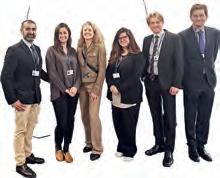
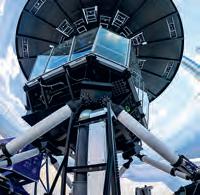
C 30 M 20 Y 10 K 40 C 90 M 45 Y 0 K 15 Magazine for maritime professionals | Volume 145, May 2024 | www.swzmaritime.nl 5 At the MEPC81 Elene Prato discusses whether IMO can keep up with the EU Making dredging more sustainable Nature-based solutions UK commits to sustainable shipping TIME TO DO BUSINESS IS NOW Being prepared for every scenario MARIN simulator centre

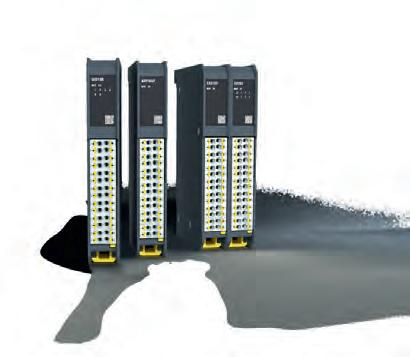

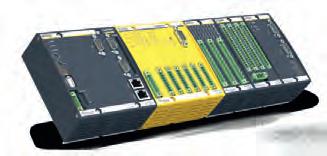


SUBMARINE DESIGN & ENGINEERING SINCE 1935

Nevesbu holds a unique position in submarine design & engineering. Since it’s establishment in 1935, Nevesbu continuously works on submarines for the Dutch navy and foreign navies. In addition to the upkeep programme for the Walrus class, Nevesbu currently works on the construction, upkeep and modification of submarines in four other countries worldwide.
Scan the QR-code to read more about Nevesbu’s submarine services and experience.

Autonomous Shipping Everything under control for the optimal route Smart Maintenance Efficient maintenance and monitoring availability Eco-Friendly Redundant, safe and environmentally friendly OpenBridge, MTP Standards for more security and smooth installation The Future in View. Always on Course. Our Competence. Our Responsibility. Our new M100 I/O System www.bachmann.info YPEAPPROVEDPRODUC DNV.COM/AF
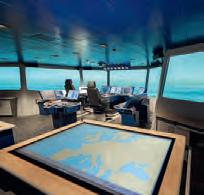
Ten years ago, the first ideas about replacing MARIN's simulator centre were launched. The new centre is now open. It focuses on research and provides the maritime industry with a platform to try out new concepts.
Seawork marks 25th year: Dutch NMT pavilion debut

T he British workboat fair Seawork is celebrating its 25th edition this year. For the first time, there will be a Dutch pavilion. A sign that the UK maritime market is becoming of increasing interest to Dutch maritime technology suppliers.

In its headquarters in London, the IMO hosted the 81st session of the Marine Environment Protection Committee (MEPC) in March. Where does the IMO currently s tand when it comes to decarbonisation of shipping?
It’s good to be nice to your neighbours
Dutch shipbuilders and suppliers often travel all around the globe to promote their products hoping to do business. But interesting markets and willing clients can also be found just around the corner. And don’t get me wrong, this doesn’t mean you shouldn't take a plane to South America, Africa, Asia, Australia, or other interesting markets overseas to make deals and bring in money. But sometimes the deals can also be found right here in Europe itself.
Big, world-class Damen, as well as Holland Shipyards, Neptune, both Bodewes yards, Ferus Smit and, in this May edition, Nauplius and NG Shipyards know that there are also orders to be won and money to be made in Europe itself. And not, like the Spanish used to do and the French recently did with the acquisition of the submarine order by buying orders, but by offering craftsmanship and quality at a fair price.
Fascinating is the story of Damen sales manager Frederik van der Linde on how Damen has secured a very strong position in the British market. Damen's success there is partly based on what has made Damen great, ships large and small based on standard designs that function well for years and provide income for their owners.
The invitation came from the organisation behind the Seawork exhibition, but some research revealed that the British market is quite important for many Dutch shipbuilders. And the UK may have left the EU because, in Boris Johnson's caricatured depiction, it no longer wanted to be dictated by the tyranny of the European Commission. But that does not mean that the UK, unlike the EU, has suddenly fallen into barbarism. The UK is also seriously working on making shipping more sustainable.
In that respect, it was very instructive for yours truly to see what the Brits are doing and, in my opinion, this has resulted in an interesting series of articles on maritime business in the UK and what Dutch shipbuilders are successful with in this market. And as a Dutchman, you can be quite proud if, when visiting a British port, especially a smaller one, it turns out to be full of ships made in the Netherlands.
But this May edition also offers real firsts in the form of articles by new, young contributors to SWZ|Maritime. Italy's Elena Prato reports first-hand on IMO's deliberations in its efforts to make shipping more sustainable. A second article worth reading is by Rui Costa, from Portugal, who gives us insight into the latest developments in maritime drones.
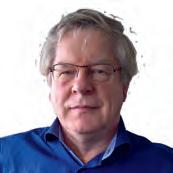 Antoon Oosting Editor-in-Chief swz.rotterdam@knvts.nl
Antoon Oosting Editor-in-Chief swz.rotterdam@knvts.nl
IN THIS EDITION
SWZ MARITIME • MAY 2024
Contents
MARIN
introduces its Seven Oceans Simulator Centre
Cover: The UK aquaculture industry has become an important market for Dutch shipbuilders. In 2023, for example, Nauplius Workboats delivered the Isaac Eslea, a hybrid aquaculture service vessel, to Inverlussa Marine Services (photo Nauplius). Can IMO catch up with the EU Green Deal? 12 9 36 4 Dutch news 6 Markets 8 Global news 14 Flourishing maritime trade between UK and NL 19 UK provides important and loyal clients for Damen 22 NG-designed monomaran crew tenders save fuel 26 Nauplius builds boats for fish farming 29 The EU and the decarbonisation of ships 32 Unmanned: An ongoing naval technology revolution 39 Passing the baton of the CEDA presidency 42 Mars Report 44 Verenigingsnieuws KNVTS 46 Advancing sustainability in dredging 3
Stena Line converts two vessels to increase cargo capacity
On behalf of Stena Line, Stena RoRo has signed a conversion contract with China Merchants Jinling (Weihai) Shipyard for the installation of an additional cargo deck, increased thruster capacity and preparations for shore power on board Stena Foreteller and Stena Forerunner. Both ships sail under the Dutch flags on the routes Rotterdam-Harwich and Rotterdam-Immingham. With the refit, the cargo capacity will increase by thirty per cent. The vessels will after conversion also be ready to meet future efficiency requirements. The conversion for both vessels will be finalised during 2025 after which the vessels will be

deployed in the Stena Line route network. In 2023, both vessels were decarbonised by changing propellers, applying silicone paint
EMSA deploys RPAS in North Sea with Danish navy
EMSA has begun a four-month remotely piloted aircraft system (RPAS) service in the North Sea, supporting the Royal Danish

Navy and Danish Customs with surveillance. EMSA delivers the RPAS service through the contractor Nordic Unmanned AS, operating a new Aerosonde Hybrid Quadcopter. The Quadcopter has both a fixed wing, enabling it to cover long distances, and four propellers, providing it with vertical take-off and landing (VTOL) capabilities. It is the first time this model has been deployed in an EMSA RPAS operation.
During its deployment, the RPAS will carry out maritime surveillance tasks in the busy waters around the north coast of Denmark.
Oceanco’s H3 wins Best Rebuilt Yacht Award
Oceanco’s H3 took home the prestigious award for Best Rebuilt Yacht at the World Superyacht Awards Gala in Venice, Italy. The goal of the H3 rebuild was to bring a very high-tech yacht from twenty years ago to today’s highest standards in terms of technology, safety, capability and sustainability. The World Superyacht Awards Gala was organised by Boat International Media and took place 3-4 May.
Under the careful supervision of The A Group and Oceanco, H3’s transformation is practically unprecedented in its scale and nature. H3 now also meets the latest environmental standards, including full IMO Tier III compliance.
Although the majority of the yacht’s original
hull remains, practically every other element on board – both technical and aesthetic – has been transformed and modernised, and its length overall now measures 105 metres. H3 displays a modern exterior look, including a completely new superstructure design, with both exterior and interior design provided by Reymond Langton Design.
New data from Oceanco’s Research and Development team shows that thanks to its Tier III compliant set-up, particularly the emission of nitrous oxide has been drastically reduced. As a result, H3’s operational footprint has been reduced by at least sixty per cent. When using an alternative fuel, such as HVO, the operational footprint re-
and adding interceptors, and the additional cargo deck will further decrease the carbon intensity index factor and further reduce CO2 emissions per cargo unit.
Niclas Mårtensson, CEO at Stena Line: ‘The conversion of the Stena Forerunner and Stena Foreteller fits with our ambition to reduce our CO2 emissions. In addition to increasing the cargo capacity by thirty per cent on both the Stena Forerunner and Stena Foreteller, we also take this opportunity to invest in onboard shore power.’ Stena recently also ordered two NewMax hybrid vessels for the Irish Sea routes with China Merchants, to be delivered in 2025.
Environmental monitoring is a key aspect of this service. The RPAS can provide information on potential oil spills and discharges at sea, complementing the CleanSeaNet satellite-based oil spill and vessel detection service provided by EMSA. The RPAS model has more than seven hours of endurance and a radio range of 140 km along the coastline, based on a ground relay station. It also has infrared and optical cameras and is equipped with an embedded automatic maritime scanning sensor.
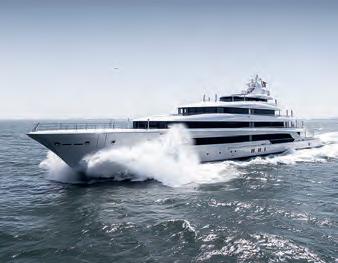
duces further due to lower CO2 emissions by almost ninety per cent compared to before its rebuild. Furthermore, figures suggest that carbon emissions related to the re-use of steel and aluminium for H3 saved approximately 2000 tonnes of carbon.
4 DUTCH NEWS SWZ MARITIME • MAY 2024
SWZ'S EDITORS
The Stena Forerunner before and after conversion (picture Stena Line).
For the first time, EMSA will deploy an Aerosonde Hybrid Quadcopter (photo EMSA).
H3’s operational footprint has been reduced by at least sixty per cent (photo Oceanco).

Growth spurt for Van Oord’s heavy-lift vessel Svanen
In just a night, Van Oord’s heavy-lift installation vessel Svanen grew 25 metres taller.
As part of a major upgrade, a huge Aframed gantry extension, weighing 1200 tonnes, has been installed on top of the vessel. The operation increased the total height of the Svanen to 125 metres, making it one of the largest heavy-lift vessels in the world.
The extension had been constructed by Holland Shipyards. One of the largest cranes in the world was used for the installation at Mammoet Schiedam. Besides the gantry extension, the upgrade
includes a modernisation of the lifting hooks that will increase the lifting capacity of the vessel from 3000 tonnes to 4500 tonnes, an improvement of the gripper to handle increased loads and a modification of the structure of the vessel to accommodate the latest hammer size. The improved Svanen will be ready for operation in the third quarter of 2024.
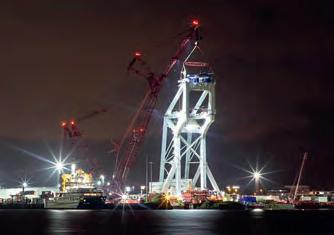
MAMII identifies tech that slashes methane slip
London-based Safetytech Accelerator, in collaboration with Capital Gas Ship Management, MSC, and Seapeak, has completed four technology feasibility studies as part of its flagship Methane Abatement in Maritime Innovation Initiative (MAMII). The outcomes of these studies showed strong potential to cut methane emissions in the maritime industry.
Daphne Technology, CDTi Advanced Materials, Inc. (CDTi), Rotoboost, and Plenesys were selected by MAMII from amongst twenty companies to help address the critical challenge of mitigating methane emis-
sions from the exhaust stacks of LNGfuelled ships.
Daphne Technology's methane abatement system outlined a potential reduction of up to 440 metric tonnes of methane annually in container ships. CDTI’s results highlighted how a proven engine catalyst could offer increased methane conversion at lower temperatures than industry norms, with minimal operational adjustments for fleets. Plenesys demonstrated a solution which can effectively reduce methane slip by 78 per cent by converting it to hydrogen, while Rotoboost’s system was found to offer sev-
Feadship launches 118.80-metre fuel-cell yacht
When the drydock doors slid open on 4 May at Feadship’s Amsterdam shipyard, Project 821 emerged, the world’s first hydrogen fuel-cell superyacht. It is also the largest motor yacht ever launched in the Netherlands.
The size of the yacht – 100-metres-plus –made it a good candidate to explore pure green hydrogen as the fuel-cell source. Feadship’s R&D team has been researching hydrogen, among other fossil-free fuel options, as part of the company’s pledge to develop “net zero” yachts by 2030. There were no regulations for hydrogen storage and fuel-cell systems at class, flagstate or even IMO level. Seeking expert partners from allied industries, Feadship, Edmiston and Lloyd’s Register developed
appropriately scaled equipment, protocols and safety regulations simultaneously. From the beginning, one of the biggest hurdles would be developing a reasonable way to store compressed liquid hydrogen below deck at -253°C aboard a luxury yacht. This requires a double-walled cryogenic storage tank. Also, it takes eight to ten times more space to store hydrogen than the energy equivalent in diesel fuel. The fuel cells developed for Project 821 can also use easier-to-store methanol, a liquid fuel in ambient conditions. Steam reforms methanol into hydrogen before the electrochemical reaction in the fuel cell. Even a yacht the size of Project 821 cannot carry enough liquid hydrogen to power a crossing, but it can serve the hotel load.
Due to the worldwide demand for renewable energy, wind farm technology is progressing swiftly, with turbines continually increasing in size. This major upgrade is preparing the Svanen to handle the next generation of monopile foundations for offshore wind projects.
eral benefits including additional revenue from carbon by-products. MAMII hopes to progress these research projects to onship trials as soon as possible.
MAMII was launched in September 2022 by Safetytech Accelerator, bringing together industry leaders, technology innovators, and maritime stakeholders to advance technologies for measuring and mitigating methane emissions in the maritime sector and promote the adoption of validated solutions. It currently has twenty leading shipping and energy companies as anchor partners.
For longer travels or when pure hydrogen is not available, the electricity powering the 3200 kW ABB pod drives comes from MTU generators combusting HVO, a second-generation biofuel that reduces harmful emissions by ninety per cent.
Project 821 is being offered for sale by Edmiston.
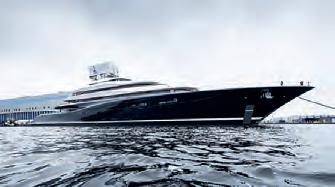
5
SWZ MARITIME • MAY 2024 FOR MORE NEWS, VISIT OUR WEBSITE WWW.SWZMARITIME.NL AND SUBSCRIBE TO OUR NEWSLETTER
DUTCH NEWS
Installation of the new A-frame on the Svanen at Schiedam (photo Van Oord)
At 118.8 metres, Project 821 is the largest motor yacht ever launched in the Netherlands.
UNITED KINGDOM OFFERS OPPORTUNITIES FOR MARITIME SECTOR
The United Kingdom (Great Britain and Northern Ireland) may not have been a member of the European Union for four years, but the British maritime market may be more interesting than ever. This is mainly due to the many investment projects launched by the British government, especially in recent years, to make shipping and ports more sustainable. The only condition for sharing in British government support may be to officially open a branch in the UK, which is still fairly easy despite the UK no longer being an EU country. This follows from the “UK market report – Opportunities & developments in the maritime sector”.
This recently released report was written by Els Steger and Maxime Dalida of the Netherlands Business Support Office in Manchester on behalf of the Netherlands Enterprise Agency. It provides a concise overview for SMEs and research institutions of trends, developments and opportunities in the area of making shipping and ports sustainable in the UK maritime sector.
‘North Sea neighbours’
‘The Netherlands and the United Kingdom are both countries in which the maritime sector has traditionally played a major role. Our highly developed relationship of trade and mutual investment go back many centuries. The so-called “North Sea neighbours both have a strong reputation when it comes to shipbuilding, navigation, maritime technology,

ports, logistics and innovation. Building on our shared maritime specialism, we are striving for a green, smart, and sustainable future for this sector. We are pleased to invite you to help us do so,’ write the report's compilers.
The rapporteurs foresee that most opportunities for cooperation and opportunities for Dutch entrepreneurs to enter the UK market are in the area of sustainability: ‘The high level of government attention in the UK to making the maritime sector more sustainable creates opportunities for sharing infrastructure and knowledge, among other things.’
Creating smart ports
Solutions to improve sustainability and digitalisation will create opportunities for Dutch entrepreneurs. 'The British government wants to grow and strengthen the maritime sector, including through investments for economies of scale. Partly due to the emergence of “smart ports”, the demand for products and services for digitalisation and automation is increasing, in addition to sustainable solutions,’ write the compilers of the report.
According to the report, there is a successful and established shipping industry in the UK. The industry contributes £ 10 billion (€ 11.6 billion) to the gross domestic product, provides 240,000 jobs and pays £ 2.5 billion in taxes in the UK. This does make the British sector a bit smaller than the Dutch. In the Netherlands, the direct added value of the combined port and maritime cluster was a whopping € 50.4 billion in 2022. The combined direct employment in the port and maritime cluster in 2022 (measured in employees) accounted for 303,960 jobs in the Netherlands.
Demise of shipbuilding
That significant difference is due in part to the almost complete demise of the UK’s still sizeable shipbuilding industry just after the war, especially in the 1950s and 1960s. The fact that the Netherlands did manage to keep a respectable shipbuilding industry afloat provides the Dutch, with their shipyards and extensive maritime supply industry, with opportunities to participate in the sustainability of British shipping. Because if there is one thing that has always remained very important in the UK, it is the shipping industry that keeps the archipelago accessi-
MARKETS
SWZ MARITIME • MAY 2024 6
MARKETS
ble for the extensive import trade. British exports are considerably smaller. The researchers note that the UK shipping industry still emits too many greenhouse gases and pollutants. UK short sea shipping contributed roughly 5% of the UK’s total domestic greenhouse gas emissions in 2020. ‘That is more than those from all buses and trains in the country combined,’ according to the researchers.
Work to be done
So in that regard, there is plenty of work to be done. ‘Products and services that provide a solution for making this sector more sustainable and developing it further bring opportunities both for further cooperation between our countries, and for entering the British market,’ state the researchers.
After pursuing an absolute laissez-faire policy since the coming to power of British Conservative “Iron Lady” Margaret Thatcher, British politics and government started getting involved in the maritime sector again in 2019 with the release of the Maritime 2050 Strategy. In it, the government sets out how best to respond to future challenges and opportunities. In this policy document, the government makes concrete recommendations for the short, medium and long term within various themes such as technology, infrastructure and environment.
Clean Maritime Plan
This strategy has since led to the formation of organisations, collaborative initiatives and funding opportunities discussed in the report. In turn, the Maritime 2050 Strategy has led to a series of plans such as the Clean Maritime Plan, which describes exactly how the route to achieving the goals around zero-emission shipping should sell.
At the United Nations annual climate summit in Glasgow in November 2021, the Clydebank Declaration was launched in which 24 countries, including the Netherlands, pledged to develop zero-emission maritime links between countries. These so-called “green shipping routes” are to become sea routes that are emission-free from start to finish, including landside infrastructure and the ships that use them.
An update to the National Shipbuilding Strategy launched in 2017 followed in March 2022, which initially focused on naval shipbuilding. With the update, the UK encourages civilian shipbuilding in the UK as well.
Green shipping routes
At the UN climate conference COP27 in November 2022 in Egypt, the Netherlands and the UK followed up on the Clydebank Declaration. Together with Norway and the US, they pledged to create six green corridors. Creating these routes is important for both the Netherlands and the UK to meet the climate goals of the Paris Agreement. Making them a reality will require, among other things, zero-emission fuel, charging points in ports and environmentally friendly ships.
The British government has allocated a maximum of £ 300 million for decarbonising the maritime sector and has set up a new division for this within the Department for Transport, the UK Shipping Office for Reducing Emissions (UK SHORE). UK SHORE is implementing a comprehensive research and development programme in partnership with industry to help build greener ships, from cruise ships to tankers and pleasure craft. The organisation aims to transform the UK into a world leader in the design and production of clean marine technologies. UK SHORE may
distribute £ 206 million in grants, which are also available to Dutch companies registered in the UK.
Great importance
The UK's many ports are of great importance. The researchers found the UK port industry is the second largest in Europe with more than 500 million tonnes of goods shipped annually and more than 60 million international and domestic passengers. The total value of cargo traffic through British ports is estimated at £ 500 billion a year. 95% of the country's imports and exports are through its ports, including 48% of its food and 25% of its energy (oil, gas and coal). The UK has over 120 commercial ports, with the largest twenty accounting for 88% of total cargo traffic.
‘ There are opportunities both for further cooperation, and for entering the British market’
The UK government envisions that UK ports will become part of a digitised and efficient supply chain that is pioneering new business models. Digitalisation and automation are to improve safety and security and reduce labour costs while creating new, highly skilled jobs. In its 2021 budget, the UK government announced investment for a range of maritime initiatives, including the designation of eight Freeports in England, the establishment of a UK Investment Bank and funding for port infrastructure to support the offshore wind energy supply chain.
Netherlands number 1
For the Netherlands, developments in UK ports are very important. With a 13% share of total UK imports, the Netherlands is the UK's main importing country, ahead of the US (11%), Norway (10%), France (8%) and Belgium (6%). The Netherlands is also the leading country for UK exports with a 21% share far ahead of France (9.2%), Belgium (8.3%), Ireland (8.3%) and Germany (5.5%).
According to the researchers, the opportunities that the British market offers to the Dutch maritime sector are the new economic clusters to be created in British port areas through the implementation of Freeports, taking advantage of the benefits of new digital and automated processes through smart ports, the increased demand for storage locations, improving connectivity through digitisation and blockchain technology and the increased need for cyber security.

Antoon
Oosting
Freelance maritime journalist and SWZ|Maritime’s
Editor-in-Chief, swz.rotterdam@knvts.nl
SWZ MARITIME • MAY 2024 7
18
Preventing the loss of seaborne containers
IACS Unified Requirements strive to improve box industry safety
GLOBAL NEWS
By Hyungmin Cho, IACS Hull Panel Chair
TPreventing the loss of containers
issues, jeopardise safe vessel traffic, and even pose an environmental hazard, if they contain dangerous goods. As illustrated in Figure 1, it is noticeable that the approximate number of containers lost at sea has recently increased. This contradicts the zero-containerloss policy that the stakeholders of the maritime container segment are striving for.
Despite efforts and technological advances towards minimising container loss, there are still serious concerns regarding this subject. The graph below show the approximate number of containers lost at sea.
he maritime container sector is the backbone of world trade and covers the worldwide carriage of some 80% of all goods. The 102 million metric tons of containerised goods transported in 1980 had grown to about 1.83 billion metric tons by 2017ii, demonstrating the importance of container trade to global commerce. Despite efforts and technological advances towards minimising container loss, a large increase in the number of transported containers has reaffirmed concerns regarding the loss of containers. Containers lost overboard imply economic
Following the investigation report of the MSC Zoe incident prepared by the IMO SubCommittee III-8 Correspondence Group (III8 CG), and interaction with the International
Figure 1: Approximated number of containers lost at sea i
Approximated number of containers lost at sea.
i IMO CCC8/11 2022, Development of measures regarding the detection and mandatory reporting of containers lost at sea that may enhance the positioning, tracking and recovery of such containers. Estimate of containers lost at sea, submitted by the World Shipping Council (WSC). ii iUNCTAD, 2017. Review of Maritime Transport 2017. United Nations Conference on Trade and Development.
The International Association of Classification Societies (IACS) assessed the safety issues related to the loss of containers and initiated a task force project. Comprising experts from member societies and approaching the problem from three aspects: operation, design and maintenance. This work should lead to unified requirements for container securing systems, lashing software and requirements of allowable wear, tear and corrosion of securing systems. These unified requirements are planned for completion in 2024 with implementation by member societies in 2025. (IACS Annual Report)
Sailing on cashew nut shells
Shipping company United European Car Carriers (UECC) collaborates with Wärtsilä, Lloyd’s Register and biofuel supplier ACT group to assess and evaluate a cashew nut shell liquidbased (CNSL) biofuel. ACT created a CNSL-based biofuel known as FSI.100, achieved through a development process including extensive engine testing and a controlled supply chain. Following testing on various blend combinations, FSI.100 received approval from engine manufacturers as a thirty per cent blend component in an ISO 8217 DMA grade distillate fuel to carry out sea trials. CNSL-derived fuels reduce waste and increase resource efficiency, aligning with circular economy principles. FSI.100 uses sustainable land use practices and exhibits maritime fuel properties, such as ultra-low sulphur and winter spec pour points. It delivers significant greenhouse gas savings. (electrichybridmarinetechnology)
Union of Marine Insurance (IUMI), IACS assessed the safety issues related to the loss of containers and initiated a task force project within the Association’s Hull Panel. The project comprises experts from different member classification societies and approaches the problem of container loss at sea from three aspects: operation, design, and maintenance.
Piracy up, hostages need saving
Lashing software is deemed to be the dominant solution in enhancing the safe seaborne transportation of containers. The Hull Panel is therefore developing Unified Requirement C6 (UR C6) to harmonise the performance standards and requirements for lashing software. Furthermore, the Hull Panel’s submission to IMO’s CCC8 to recognise lashing software as an additional means to supplement container stowage and securing plans, included in approved cargo securing manuals, received support in principle. However, the general view of the sub-committee was that harmonised performance standards and guidelines are required to permit the approval of lashing software to be carried out in a consistent manner. Consequently, a new output proposal was prepared by the Hull Panel and submitted to MSC 107 to introduce the supplementary use of lashing software together with the development of performance standards for lashing software to allow for uniform approval by flag State Administrations. Additionally, a follow-up proposal to revise the ‘Revised Guidelines for the Preparation of the Cargo Securing Manual’, (MSC.1/Circ.1353/
Global piracy and armed robbery incidents increased again in 2023 after a two-year drop, with the first quarter of 2024 following suit. While the Gulf of Guinea waters and the Singapore Strait stand out as long term piracy hotspots, the return of Somali pirates in the Western Indian Ocean raises concerns, as does the increasing use of violence against crews. On a related subject, the world leading shipping associations have highlighted the inequality seafarers face as hostages. In April, the Iranian Navy hijacked the 15,000 TEU MSC Aries. Meanwhile a car carrier, the Galaxy Leader, having been hijacked months ago by the Houthis, was held in Yemeni waters. Somali pirates have abducted two ships off the Horn of Africa. An open letter by sixteen shipping organisations to the United Nations secretary-general, Antonio Guterres, states: ‘Innocent seafarers have been killed, seafarers are being held hostage. This would be unacceptable on land, and is unacceptable at sea. The world would be outraged if a couple of airliners were seized and held hostage with innocent souls on board. Regrettably, there does not seem to be the same response or concern for the commercial vessels and their crews being held hostage.’ (Lloyd’s List, Gard and Splash247)
EU fishermen catch fewer fish
In 2023, EU fishermen caught 2.8 million tonnes of live weight fish. Down from around 6 million tonnes in 2000, according to EU figures. As the effect of Brexit will take place over the period 2021 to 2026, these figures have not yet been seriously affected by Brexit. It has been a more or less gradual downturn from 2000 to 2023. In the same period, the amount of fish produced within the EU by aquaculture was about constant at 1 million tonnes. As a consequence, the EU needs to import much more fish. According to figures recently reported by the Dutch fish processing and wholesale organisation, the demand for fish of EU consumers is such that each year some 9 million tonnes of fish have to be imported from outside the EU. Our country needs 2.1 million tonnes of imported fish for its total consumption of about 2.5 million tonnes. In the Netherlands, these relatively fast changes in the fishing industry have led to a growing fish processing and trading business, importing, processing and selling fish, in total employing some 7000 workers with a turnover of about € 4.5 billion. (Visserijnieuws and EU figures)
Global news gathers news from different media. Our website, www.swzmaritime.nl, also covers global maritime news. Receive the latest maritime news directly in your inbox by subscribing to our newsletter. Scan the QR code now!

8
SWZ MARITIME • MAY 2024
IR WILLEM DE JONG, WILLEM.DEJONG3@GMAIL.COM
6000 5000 4000 3000 2000 1000 0 3 Year moving average Total loss 20082009 2010201120122013201420152016201720182019 20202021

MARIN INTRODUCES ITS SEVEN OCEANS SIMULATOR CENTRE
The Maritime Research Institute Netherlands (MARIN) is perhaps best known for its tank test facilities. But since the early seventies, bridge simulations have played a significant role. Between 1992 and now, a bridge simulator centre was operated consisting of several full mission bridges and a number of small part task simulators. Ten years ago, the first ideas about replacing this centre were launched. The new simulator centre is focused on research and provides the maritime industry with a platform to try out new concepts.
Bridge simulators have always played an important role in MARIN’s portfolio. Since long, they have been the link between the operational concept and the actual operation on board. This link is even stronger now with the Seven Oceans Simulator Centre (SOSc). New state-of-the-art simulators offer unprecedented possibilities to simulate all aspects of operations at sea and give the human operator a central stage. Having access to modern test basins and the latest computational fluid dynamics (CFD) tools, the hydrodynamic and seakeeping behaviour of our manoeuvring and motion models has always been our strong point. Together with the inhouse developed Dolphin simulation software. Now, this is complemented with brand new simulator facilities and up to date visual rendering techniques. The ambition is to make maritime operations, port and fairway lay-outs and ships (equipment) safer and more efficient with the most realistic simulations of the behaviour and interactions of maritime constructions, the environment and the human operator.
Wide views, motions and manoeuvring
The working horses of the SOSc are the two large ship simulators
LMS and FMB. LMS stands for Large Motion Simulator, and that is exactly what it is. This is truly a one of a kind facility, consisting of a ship’s bridge fitted on a motion base assembly. Unique is that the bridge is surrounded by a spherical screen on which the outside world is projected. This gives a very large vertical field of view that makes it possible to see the quay directly next to the ship, when mooring. This is also very relevant in ship-to-ship, seabasing and launch and recovery operations. This large vertical field of view is also necessary to ensure that the bridge team remains immersed in the scene, whilst undergoing large motions. The motion platform is capable of angles up to 30°. All ship operations in which motions play a significant part can be simulated realistically. Think of, steering in high waves, operating wind-assisted vessels, parametric rolling or research into capsizing events. Now, this facility offers the opportunity to conduct human factor research and development under these conditions with a team of operators.
The Full Mission Bridge (FMB) is a very large bridge simulator. It is 16 metres wide and equipped with two bridge wing positions. It provides sufficient room for a large bridge team, with multiple flexible work spaces. Flexibility is the key word here. Not only the controls
9 SWZ MARITIME • MAY 2024 RUBRIEK SIMULATIONS
Photo: The Large Motion Simulator is a 6° of freedom motion-based bridge of 4x5 metres on a hexapod with a payload of 14,000 kg and 360° projection in a large spherical dome with a diameter of 16 metres (all pictures by MARIN).
SIMULATIONS

The Full Mission Bridge is a 16-metre wide bridge with a forward and backward (flat screen) view on a cylindrical screen (240° horizontally and 42° vertically). Both bridge wings have 6-metre diameter domes to allow for forward, backward, downward and upward views.
All simulators in the SOSc can be coupled and operated from various operating stations
can be easily changed, also the set-up of the consoles can be re-arranged, ranging from a typical T-console and a one man bridge, to a twin battery of consoles typically found on cruise vessels. A lot of attention has been paid to details, creating the look and feel of a large modern ship. The bridge wings have their own spherical projection domes and together with the main projection, they provide 360° coverage. From the bridge wings, you have excellent views along the ship, perfect for manoeuvring close to the berth, side-by-side another ship or when conducting launch and recovery operations. In essence, this simulator is ideal for manoeuvring simulations with a large variety of ship types.
Multi-Purpose Simulators
For the simulation of smaller ships, four Multi-Purpose Simulators (MPSs) are available. These versatile simulators can be used for smaller vessels, such as tugs, inland vessels and suppliers. They
consist of a one-man bridge set up, with radar, ECDIS, conning and alarm screens. Visuals are provided through large TV screens in portrait mode, providing a 360° view. Two of the MPSs are equipped with additional screens on floor and ceiling, so they can be used for crane operations.
All simulators in the SOSc can be coupled and operated from various operating stations. This makes it possible to conduct simulations where a large ship (on the LMS or FMB) is assisted by one to four tugs operated from MPS simulators. In the near future, MARIN will also couple to other simulators outside MARIN.
Traffic & Mission Control and Maritime Experience lab
One of the new features in the SOSc is a Traffic & Mission Control room. The T&MC will function as a laboratory to test new Vessel Traffic Services (VTS) concepts and innovative solutions for remote/ unmanned control operations. It can be coupled to the other simulators, and as such, it also provides the capability for large scale crisis response exercises, in which manned simulated vessels can cooperate in coordinated rescue operations.
Another novelty is the Maritime Experience lab. The MX lab with its large open floor plan, offers the possibilities to mix virtual reality applications (virtual, augmented and mixed reality) with all kinds of motion platforms. With this mix, MARIN is able to include other parts of the operations on board of vessels, beside the navigation bridge. For example, the sailors working on the deck of an offshore
10 SWZ MARITIME • MAY 2024
RUBRIEK
RUBRIEK SIMULATIONS

supply or navy vessel can now be included. The Fast Small Ship Simulator with its motion base and a cable robot are some of the features of the MX lab. One of the projects already scheduled in the MX lab is the development of a set-up to test concepts for pilot boarding.
Human operator in focus
All the calculations and visualisations necessary to run the simulations are performed in the high performance computer centre. The computers are connected through a fibre optics network to all the controls and displays of the simulators. The combination of central processing units (CPUs) and graphics processing units (GPUs) provide the computing power to include highly complex hydrodynamic calculations.
Wearable sensors enable MARIN to “catch” the human factor even better
However, the human operator will be the centre of focus. For this reason, a specially developed toolkit with wearable sensors has been developed that allows
the researcher to observe specific human factor measures (eye-trackers, heartrate, galvanic skin response and so on) and log this data together with all technical data coming from the simulators. This will enable MARIN to “catch” the human factor even better.
Safer and more efficient
The SOSc includes four fixed and two mobile Instructor Operator Stations from which the simulations are controlled. It is possible to simulate with whatever combination of simulators in one scenario. Excellent debriefing facilities offer extensive replay functionality. Everything with the aim to provide the research facility with which MARIN can make maritime operations safer and more efficient with the most realistic simulations of the behaviour and interactions of maritime constructions, the environment and the human operator. The SOSc will be officially opened on 28 May.
 Dimitri van Heel Senior projectmanager/teamleider Maritime Operations, d.v.heel@marin.nl
Dimitri van Heel Senior projectmanager/teamleider Maritime Operations, d.v.heel@marin.nl
11 SWZ MARITIME • MAY 2024
The Traffic&Mission Control room is a multi-purpose and flexible control room with projection on three walls to simulate command and control centres on board or ashore, and operator stations for VTS and remote control operations.

SEAWORK MARKS 25TH YEAR: DUTCH NMT PAVILION DEBUT
The British workboat fair Seawork is celebrating its 25th edition this year. For the first time, there will be a joint stand of Netherlands Maritime Technology (NMT), the Dutch maritime manufacturing industry's interest organisation. A sign that the UK maritime market is becoming of increasing interest to Dutch providers of maritime technology, from working vessels to a broad package of maritime equipment that the UK desperately needs to make its shipping and ports more sustainable.
The fair takes place from 11-13 June at Mayflower Park, in the old part of port city Southampton's centre on the River Test. It is near the cruise terminal at the site from where the disaster ship Titanic once departed for what would be its first and last dramatic crossing of the Atlantic. The fair includes 12,000 m2 of exhibition space. NMT is at the fair with a Dutch pavilion that houses fifteen Dutch maritime small or medium-sized enterprises (SMEs). In addition, there are about fifteen more Dutch suppliers with their own stands, such as Damen Shipyards, offshore shipowners Acta Jifmar from Den Helder and Seazip Offshore Service from Midlum, and shipbuilders Nauplius Workboats from Groningen, Next Generation Shipyards from Lauwersoog and Neptune Marine from Hardinxveld-Giessendam. NMT is hosting an NL Networking Event with drinks on Wednesday, 12 June, between 3 and 5 pm at the Waterfront Restaurant.
Demonstrations with ships
As a trade fair, Seawork has grown steadily since its inception in 1998. From 1000 visitors in its inaugural year, last year's show at-
tracted 7200 visitors from sixty countries. The fair also incorporates sister event Marine Civils, Europe's leading event dedicated to showcasing the latest equipment and solutions for marine, coastal and other challenging civil engineering projects with unique landscape features. Adjacent to the waters of the Port of Southampton, the fair also provides an opportunity to exhibit and demonstrate workboats. More than seventy vessels and other types of craft are expected for demonstrations on the water. The eighteen conferences were attended by more than 1000 visitors last year, and forty new products and services were presented at the fair itself. Seawork also provides an opportunity to get in touch with organisations and governments for a chance to participate in the many projects especially in the field of achieving climate goals. Also see our Markets section on pages 6-7 of this issue of SWZ|Maritime.
Conferences
The popular and highly regarded conference programme for Seawork 2024 will be focussed on “The future fuel matrix & OPEX reduction”. Decarbonisation to reduce emissions and costs remain
12 SWZ MARITIME • MAY 2024 SEAWORK
Photo: More than seventy vessels and other types of craft are expected in Southampton for demonstrations on the water (photo Seawork).
SEAWORK
top of the agenda at Seawork. The conferences will share insights and learnings on key themes that are at the forefront of discussions across the industry. The free to attend bitesize sessions will tackle how the latest regulations are driving change for fleet operators, vessel manufacturers and designers, what cutting edge technology is delivering for the commercial marine sector in the race to provide future fuel options, plus, the advantages and challenges with battery technology for commercial marine applications including workboats in meeting their day-to-day operational needs.
Session 1 is on green technology – the impact of regulatory changes for workboats and how this is driving change. The session “The future fuel mosaic” deals with the latest developments in methanol, hydrogen, and sustainable future fuels. The third session is about battery technology, an opportunity, or a challenge for workboats?
Government services
Government agencies such as the National Shipbuilding Office (NSO), the Ministry of Defence (MoD) and the Department for Business and Trade (DBT) have a strong presence at the fair to inform and, where possible, encourage developments and innovations. The NSO oversees implementation of the National Shipbuilding Strategy Refresh, providing strategic oversight of all the government's interests in UK shipbuilding and its supply chain. The NSO's mission is to collaboratively support growth across the sector, encouraging innovation, promoting skills, improving productivity, and driving international competitiveness.
The MoD is always looking for good suppliers or providers of maintenance both nationally and internationally, and the DBT has budgets available for innovative projects in which Dutch companies may be able to participate through collaboration.
Increasingly international
Since its inception in 1998, the fair in Southampton has become increasingly international. Last year, more than a quarter of exhibitors came from overseas, with twenty per cent from Europe and the rest from elsewhere in the world. To further facilitate the international exhibitors, this year, for the first time, there are two country stands. In addition to that of NMT, Seawork also welcomes an Italian pavilion, organised by the Italian Maritime Industry Association Confindustria Nautica, a national non-profit institute representing the Italian superyacht industry nationally and internationally since 1976.
Opening by Princess Royal Mercator Media, organiser of Seawork, is delighted to announce that Her Royal Highness The Princess Royal Anne MountbattenWindsor, sister of King Charles, will officially open Seawork on Tuesday, 11 June, marking Seawork's 25th anniversary. The Princess Royal has visited Southampton many times, but this will be her first visit to the city’s Mayflower Park for the Seawork exhibition. Seawork offers a combination of purpose-built undercover exhibition space, open air displays and over seventy vessels, floating plants and equipment on the quayside and pontoons. Attendees include representatives of the UK government and agencies, industry associations and experts, port users and customers, maritime chari-
ties, apprentices and academia. Seawork has many longstanding strategic partnerships with relevant industry associations that offer support to their members at the event.
Very special year
Decarbonisation to
reduce emissions and costs remain top of the agenda at Seawork
Andrew Webster, chief executive, Mercator Media, says: ‘Seawork is honoured that Her Royal Highness the Princess Royal has chosen to officially open the 25th anniversary edition of Seawork. Her visit marks a very special year for Seawork and for everyone involved in this vibrant sector of the maritime industry. Seawork is the key meeting place for the commercial marine industry, welcoming an international audience of visitors and exhibitors each year. The exhibition provides an international platform for commercial marine businesses to connect with buyers, network with their clients and discuss innovations and solutions within their respective industries.’
Innovation Awards
To celebrate the 25th edition, new categories have been introduced of the European Commercial Marine Innovation Awards (ECMAs). The awards are designed to showcase the extensive progress made in design and technology in the commercial marine industry. The new Innovation Awards reflect the shifts in industry focus, towards decarbonisation, sustainability, automation, alternative energy, and propulsion. Judged by a panel of industry experts, chaired by the editor of Maritime Journal, the ECMAs are presented at the awards evening on Tuesday, 11 June. The categories for the Innovation Awards are Vessel Design & Construction, Marine Power & Propulsion, Safety & Training, Underwater Intervention (Diving & Underwater Technology), and Marine Equipment & Materials. New are Electronic & Electrical Systems, Navigation & Communication, Autonomy, Environmental/Renewable Energy and Deck Equipment. The categories for the People & Project Awards are Marine Civils Best Project, Maritime Sustainability, Young Person’s Development, Maritime Professional of the Year, and Lifetime Achievement.

Antoon Oosting
Freelance maritime journalist and SWZ|Maritime’s editor-in-chief, swz.rotterdam@knvts.nl
13 SWZ MARITIME • MAY 2024

FLOURISHING MARITIME TRADE BETWEEN UK AND NL
Over 25 Dutch companies at Seawork
More than 25 Dutch companies exhibit at Seawork, the largest wet shipping fair for commercial marine and workboats in Europe. It takes place in Southampton from 11 to 13 June.
One of the Dutch companies is Fender Innovations from Wieringerwerf, manufacturer of flexible custom-made fenders for work vessels, naval vessels, SAR vessels, superyacht tenders, and so on. The fenders can be produced in any desired shape and length, have a smooth surface and are up to twelve times lighter than traditional rubber fenders, which can result in significant operational cost savings.
Since 2012, Fender Innovations has been present at every exhibition and operational manager Sylvia Ruizendaal is still enthusiastic about it. ‘It is a relatively small exhibition that really focuses on the smaller work vessels, ribs and fast-sailing work vessels. The exhibition is excellently organised. The fair is visited by large and small shipowners looking for solutions to issues they encounter in practice. As a specialist in fender systems, we can provide solutions for issues in this area.’
The fenders from Fender Innovations have a closed cell foam core protected by a strong layer of polyurea, reinforced with other materials if necessary. ‘All materials we use for production are adapted to our wishes,’ says Ruizendaal. ‘As technical development never stands still, new materials and techniques are being tested thoroughly and added to improve our fender systems. We are an innovative company in that respect. From the start, we have been building fenders that will last a ship's life under normal use, but when you compare the fenders of the past with those of today, they have be-
come even better. We have excellent in-house draftsmen, milling programmers and instructors. We train our employees internally and have sufficient staff with sufficient recruitment. We are a great family that helps and supports each other.'
Sturdy workboats
A completely different Dutch company at the fair is Tideman Boats from Hoorn, which specialises in the construction of fast workboats. The black high-density polyethylene (HDPE) hulls of these boats are maintenance-free and do not require fenders at all. According to director and owner Bruno Tideman, the material is indestructible. This year Tideman will be at Seawork for the fifteenth time. ‘Seawork is one of the few wet shows for workboats,’ says Tideman. ‘Every workboat has its unique selling point and sells best when the customer can take a test run. That is better than standing at a dry fair with a boat on a trailer in a large hall. Furthermore, in the workboat world, it is important to show that you are still there. That works better than fancy websites. Customers want to see the product and the people behind it.’ Tideman also experiences the fair in Southampton as a bit of a holiday. ‘The weather is always nice, and it is nice sailing on the Solent.’
Yet, it may be the last time Tideman exhibits at Seawork. ‘We are organising a wet workboat show in Hoorn with all Dutch workboat
14 SWZ MARITIME • MAY 2024 SEAWORK
Photo: Tideman Boats built a series of fast pilot boats for P&O. This pilot boat (11 x 3.20 metres) is now sailing in the port of Maputo (Mozambique), where P&O provides pilotage and other services (photo Tideman Boats).
SEAWORK
builders on October 15, 16 and 17. If it is a success, we will organise it again in spring next year. Then our Dutch customers no longer have to come to England to test the workboats, which is simply not very convenient for them. Moreover, there are no speed restrictions on the Markermeer, and you have plenty of space. In Hoorn, we are with six boat builders close together and are having a party in October. So, it is probably the last time I'll be at Seawork.’
Financial innovation
‘Customers want to see the product and the people behind it’
Beequip MKB Equipment Lease from Rotterdam is specialised in financial engineering. Beequip exhibits at Seawork for the second time. The company provides financing with lease constructions for heavy equipment such as cranes, trucks and ships. A shipping company can sell ships to Beequip and rent them back via a Sale & Lease Back contract. The company pays back an agreed amount per month and at the end of the contract it regains full ownership of the ships. The money released in this way can be used for growth or the acquisition of another company.
‘We find anything larger than a company van interesting for this kind of financing, including ships,’ says Beequip's marketing and events coordinator Kevin van ‘t Oor. ‘When we provide financing, we strongly focus on the equipment's value. This also allows financing of used equipment, which

DCBright developed the world's first full 316 Stainless Steel LED floodlight. With 42,000 Lumens, it can light up an area of up to 600 metres (different beam options available). The 316 stainless steel housing offers protection against corrosion and weighs just 16 kilogrammes (photo DCBright).
is of interest to SMEs. We look at the equipment and share our risks with several financiers. For us, the maritime market is an interesting market where the equipment keeps its value well. The UK is interesting in this respect as an island. Everything is by ship and the laws and rules are like those in the Netherlands. That is nice, and the UK is by nature a leasing country. That makes it easier to talk.’
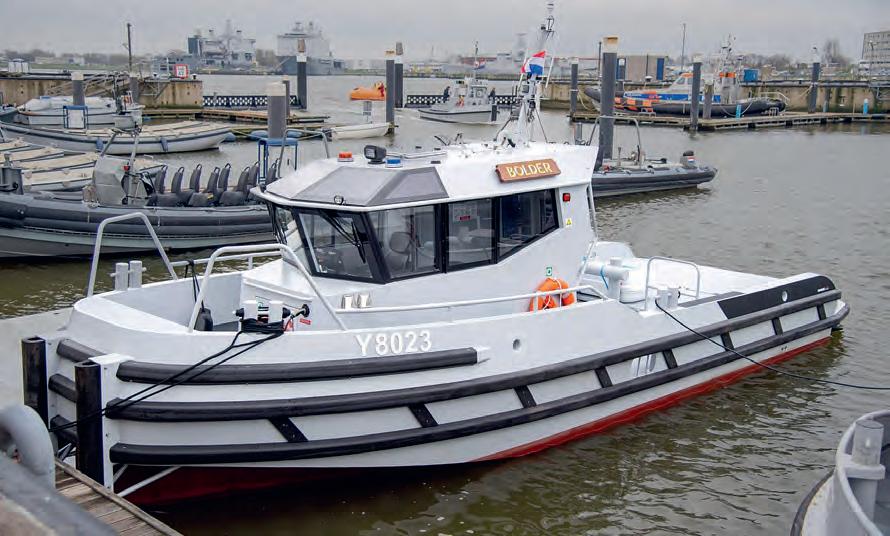
15 SWZ MARITIME • MAY 2024
The Bolder is the first of a series of three fully electric Harbour 110 Line Handling Workboats that Stormer Marine is building for the Royal Netherlands Navy (photo Royal Netherlands Navy).
SEAWORK
In addition to financing used ships, Beequip offers financing with lease contracts for new ships. Beequip has a strong financial partner. ‘We apply our own rules and operate independently. We work with the NIBC Bank for our financing.’ This investment bank is based in The Hague and has belonged to the Blackstone Group since 2021.
According to Van 't Oor, Beequip’s employees have in-depth knowledge of the equipment they finance. ‘Our people have years of experience in the field of heavy equipment, trucks, or ships. They are all people who come from the market. During Seawork, I will be at the fair with sales director workboats and maritime equipment Joost van den Berg. He worked at Damen for years, knows how ships work, understands the customers, and can assess the risks well. At our coffee stand at the Workboat Association, you can get a nice barista coffee.’ Companies and their customers can go to Beequip, have coffee, and talk about financing. ‘Last year, it was very busy,’ says Van 't Oor. ‘It is an interesting fair for us.’
Innovative battery systems
Est-Floattech from Badhoevedorp specialises in maritime battery systems. It presents an innovative “Octopus Series” battery system at Seawork. This system is specifically designed and certified (DNV, Bureau Veritas and Lloyd’s Register) for commercial maritime applications.
For EST-Floattech, the UK is a potential growth market. ‘We see that electrification of the maritime sector in the UK is catching up. This transition is partly accelerated by local government subsidies,’ says marketing and communications manager Frederique Hoppe. ‘That makes Seawork interesting as it is known for the high visitor numbers and the strong focus on workboats.’
EST-Floattech is involved in several British projects, including the supply of a 2400-kWh EST-Floattech Octopus High Energy battery system for the E-LUV (Electric-Landing Utility Vessel), which is being built on the Stornoway-based shipyard of Coastal Workboats. The E-LUV will be the UK's first fully electric workboat.
EST-Floattech also supplies the Shore-based Power Supply System (SPSS) for the E-LUV and an additional 1200-kWh Octopus High Energy battery system in a 20-foot container to support the charging of the vessel's battery system. It is also possible to place the energy container on board as a range extender.
EST-Floattech will also deliver battery systems to the Wight Shipyard for installation in new ships for London's Thames Clippers. Service engineers from EST-Floattech take care of the commissioning of the battery systems in the UK.
Azimuth thrusters
Azimuth thruster producer Hydromaster from Rotterdam exhibits at Seawork for the eighth time. Hydromaster specialises in the production of azimuth thrusters in a power range of up to 1 MW. The originally British company came into Dutch hands in 2015 and moved production completely to the Netherlands after Brexit. In recent years, Hydromaster strengthened its position on the Dutch and European market, and also remained active in the UK, where it is still an established name.
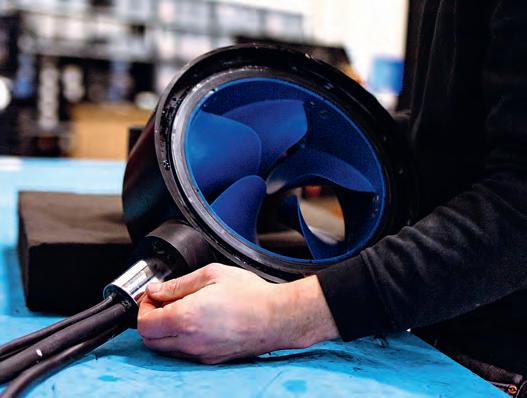
‘We have several contracts in England for the supply of azimuth thrusters,’ says sales director Jan Terlouw. ‘We are currently building a set of azimuth thrusters for a 24-metre fully electric ferry currently under construction for Thames Clippers by Wight Shipyard. It will sail in the area around Canary Wharf crossing the Thames river. We also supply two 210-kW azimuth thrusters for the fully electric E-LUV workboat that Coastal Workboats builds (in collaboration with Damen).’
Hydromaster is building fifteen heavy-duty deck mounted azimuth thruster units for the British Ministry of Defence (MOD) to propel so-called Mexeflote pontoons. These modular landing vessels are used by the United Kingdom's Royal Logistic Corps (RLC) to move goods and vehicles between navy ships and the shore. ‘This is a great contract we have been working on for years,’ says Terlouw. The RLC is based at Marchwood, opposite the Seawork venue at Mayflower Park.
Another project Hydromaster is working on is the build of a 40-metre DP2 diesel electric multi-role vessel, currently under construction at Freire Shipyard in Spain for UK operator Briggs Marine. This vessel is being equipped with two 640-kW Hydromaster azimuth thrusters in combination with two 315-kW tunnel thrusters.
Another vessel getting close to completion is a research vessel for Marchall Jakeman Marine Ltd, fitted with an azimuth thruster for DP purposes.
A long-standing reference in the UK for Hydromaster are the two 60-metre double ended ferries operated by Transport for London. For over six years, these ferries have been crossing the Thames River at Woolwich.
Rim drives
RIM Drive Technology from Wanraay exhibits at Seawork for the first time. RIM Drive makes electric shaftless pod propellers and bow thrusters, known as rim drives.
‘We started development in 2016 and officially founded the company in 2019,’ says sales associate Lennaert van den Berg of Rim Drive
16 SWZ MARITIME • MAY 2024
Mounting of an 11-kW rim drive pod in the workshop of RIM Drive Technology at Wanraay (photo RIM Drive Technology).
SEAWORK
Technology, which builds E-pods with power ranges from 0.5 kW to 50 kW. A 75-kW RIM Drive is currently under development.
‘We are showing our entire product range at Seawork, including a steerable RIM drive pod propeller. We will hang it in a water container to be able to demonstrate our innovative rim drive technology. Visitors will have the chance to experience our steerable pod in action. You don't see many shaftless propellers yet, so we expect that we will be quite unique at the fair. Entering the British market more actively is a strategic goal for us at this exhibition.’
‘Entering the British market more actively is a strategic goal for us at this exhibition’
The Rim Drive pods from RIM Drive Technology have an aluminium housing, filled with epoxy. The tube of the RIM Drive contains a stator with a permanent magnet. The rotating inner ring with the propeller blades holds the rotor. The propeller blades are made of plastic composite. The pods are offered in capacities from 0.5 to 50 kW. The Rim Drive azimuth thruster is a direct electric drive thruster using permanent magnet
technology, with low environmental footprint. The permanent magnet (PM) motor does not need an internal cooling system or lubrication pumps.
Crew agencies
Two Dutch crew agencies are active at Seawork, Orca Crew Services from Middelburg, and Delta Marine Crewing from Vlissingen. Delta Marine wants to further increase its customer contacts and maintain the existing contacts.
‘There are crew shortages across the EU that will only increase in the coming years and the UK is no exception to this,’ says Jack Zeijderveld of Delta Marine. Recruiting sailors in countries where this does not yet happen offers new opportunities to solve this problem. ‘But when all the maritime companies subsequently appear there, a source from which we can recruit well quickly produces fewer candidates,’ says Zeijderveld. ‘And new countries must be recognised by the Ministry. You cannot recruit everywhere. There must be a plan behind it and that differs per country.’
Although there are crew shortages in the UK, Delta Marine works with English sailors on certain projects. ‘On some projects, this is extremely attractive, and it works well. These are tailor-made solutions for specific situations that require attention. But we can still meet the needs of our shipowners quite reasonably.’
Innovative work deck lighting
The Dutch-Chinese company DCBright is exhibiting for the first time at Seawork. DCBright manufactures efficient LED lighting products

17
In November 2023, Fender Innovations supplied the engineering, production and mounting of an innovative, ultra light fender system for the new pilot vessel Golden Gate of the San Francisco Pilots USA (photo Fender Innovations).

for industrial, construction, sports, and off-road applications. It is now expanding its activities to the maritime world.
‘DCBright will be at the fair with fixtures and floodlights for ships and platforms,’ says contact person Jaap de Graaf. ‘A good example of our maritime activity is the deck lighting on the Bokalift 2 from Boskalis. We are also doing projects with Mammoet. With our new floodlight line, we focus on the maritime sector.’
For the maritime floodlight line, DCBright uses stainless steel fixtures and housings. ‘That is quite unique because stainless steel conducts heat much worse than aluminium,’ says De Graaf. ‘Stainless steel lamps from competitors often contain aluminium parts for the heat transfer, but this is no longer present in these fixtures.’
DCBright makes lighting plans to properly illuminate work decks.
‘On fishing vessels, they often hang a few lights and when it is not enough, they hang up some more,’ says De Graaf. ‘We first make a 3D drawing of the ship and look where the lights can hang best and how we can illuminate the ship properly from there. Our stainlesssteel fixtures may be more expensive, but if you need fewer fixtures, due to a good lighting plan, it may still be cheaper. The Dutch installer Piet Brouwer, from Urk, is now testing our new floodlight line on a fishing vessel. We will receive his feedback soon.’
The 316L stainless steel LED floodlight fixtures should last a ship's life or longer. DCBright's production in China is managed by Dutchman Niels Woelders, who emigrated with his family to Shanghai. Woelders is the managing director of DCBright. The
designing offices are in the Netherlands and Australia and the production base is in China.
Stormer Marine
Stormer Marine has a shipyard in Hoorn and builds aluminium workboats for professional clients worldwide. The company has a lot of experience in building electric and hybrid workboats. Using aluminium makes them considerably lighter than when steel is used.
Stormer builds workboats for different applications such as tugs, patrol boats, rescue boats, porter boats, harbour boats, and RIBs. Motorisation options are gasoline, diesel, electric or hybrid.
All technical components come from renowned suppliers such as Yanmar, Steyr, Volvo Penta, Yamaha, Mercury and Vetus. Stormer always pays special attention to the electrical system, a prerequisite on aluminium vessels. For The Royal Netherlands Navy, Stormer Marine is building three electric Line Handling Workboats (LHWBs).
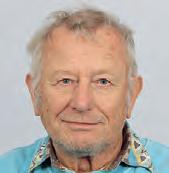 Hans Heynen
Hans Heynen
Maritime journalist, hans.heynen@casema.nl
18 SWZ MARITIME • MAY 2024
SEAWORK
Hydromaster supplied, among other things, the rudder propellers for two Woolwich ferries (62 x 19 metres). They sail between Woolwich and North Woolwich, linking the north and south circular roads, across the Thames (photo Jan Terlouw).

UK PROVIDES IMPORTANT AND LOYAL CLIENTS FOR DAMEN
Companies in the UK maritime sector are very important and loyal customers for Damen Shipyards. Since the 1970s, Damen has delivered an impressive 300+ ships to a high variety of customers and industries in the United Kingdom and Ireland. Some ten to twelve vessels are currently under construction as well.
This makes the United Kingdom and Ireland ‘a very important market’ for Damen, says Frederik van der Linde, sales manager United Kingdom and Ireland, and one of the two permanent salespeople Damen has within its organisation in this market. In June, he is one of Damen's hosts at the Seawork exhibition in Southampton. That will mark the 25th time in Seawork's 25-year history. ‘Damen supported Seawork from the beginning as it’s a great way to get in contact with clients and industry people off the ground,’ says Van der Linde. He works on the UK market together with his colleague Mike Besijn with the support of colleagues at the shipyards and other offices.
Dredging and offshore wind
The vessels that Damen delivers to clients in the United Kingdom and Ireland originally involved a lot of small workboats for the local dredging industry such as Stan Tugs, Pushy Cats, and other types of
workboats. Later, these were supplemented by Shoalbusters and Multi Cats. With the rise of the offshore wind industry, Fast Crew Suppliers (Crew Transfer Vessels) also find their way to clients. ‘Our customers are spread throughout the UK and the Damen portfolio turned out to be very well suited to demand,’ Van der Linde explains Damen's success in the UK market.
The UK government, including the UK Ministry of Defence, also appreciates Damen's products. A recent noteworthy example is the 42-metre axe bow type XV Patrick Blackett (X01), an experimental ship used by the Royal Navy as a testbed for new technologies, including unmanned underwater and surface vehicles, and quantum navigation. Its namesake is Patrick Blackett, a Royal Navy veteran, and Nobel Prize-winning British physicist.
Painted matte black
The Patrick Blackett is an adapted Fast Crew Supplier 4008 (FCS
19 SWZ MARITIME • MAY 2024 RUBRIEK WORKBOATS
Photo: The Patrick Blackett is an adapted Fast Crew Supplier 4008 (FCS 4008), designed and built by Damen Group and painted matte black (all photos by Damen).

4008), designed and built by Damen Group. It is painted matte black, rather than the Royal Navy's standard Pusser's Grey, complete with NavyX insignia on both sides of the hull. Its pennant, X01, is also uniquely highlighted in gloss paint and large QR codes are painted to either side of the superstructure, allowing smartphone users to scan them and view NavyX content. It is capable of speeds more than 20 kn (37 km/h; 23 mph), with a range of more than 3000 nautical miles (6000 km) at 20 kn (37 km/h).
pin the Damen ships in the UK as well as provide support with original construction drawings and maintenance instructions when docking, for example. The Damen Hub also offers its support to nonDamen ships.
Larger ships
‘We feel welcome in the UK. It's good business there.’
The breakthrough to the UK government market was the delivery of four Stan Patrol 4207 patrol vessels in 2007 for British Customs and later the UK Border Force. This made British Customs the second customer for Damen for this type of vessel after the delivery of the Sea and Osprey in 2001 to the Dutch Coast Guard. And even though they are almost twenty years old, they are still doing very well.
Damen Service Hub
Van der Linde: ‘We opened a Damen Service Hub in Southampton in 2021 with four full time FTEs including an ex-Royal Navy man and a technician.’ In doing so, the Damen Service Hub should help under-
Damen Shipyards builds between six and nine vessels annually for UK clients. These have increasingly been larger vessels in recent years. Multi Cats nowadays range from 12 to 37 metres in length. Two years ago, Damen delivered the second Marine Aggregate Dredger, a MAD 3500, to Hanson UK following an earlier one to Cemex UK Marine, for winning aggregates from the seabed for the construction industry. The MAD 3500 has a hopper capacity of 3500 m3. In 2017 and in 2019, Damen delivered two Walk-to-Work Vessels to Bibby Marine, the Bibby Wavemaster 1 and Bibby Horizon. At that moment, the first purpose-built design Walk-to-Work Vessels for the offshore wind industry.
Much success has also been achieved recently by Damen in the delivery of FCSs, also known as Crew Transfer Vessels (CTVs), a catamaran for fast transport of technical personnel for the maintenance of offshore wind turbines. ‘In the construction of offshore wind farms, the UK industry is very advanced,’ Van der Linde says in clarification. Meanwhile, Damen has delivered over thirty FCSs to customers in the UK over the last fifteen years. One example is UKbased High Speed Transfers (HST), which started in 2018 with an order for the delivery of one FCS 2710, followed by three more very quickly.
20 SWZ MARITIME • MAY 2024
RUBRIEK WORKBOATS
Purus Wind ordered no less than eight vessels from Damen in one go, includig one 90-metre Construction Service Operation Vessel (CSOV).
RUBRIEK WORKBOATS
‘Our very diverse portfolio allows us to serve a lot of different customers’
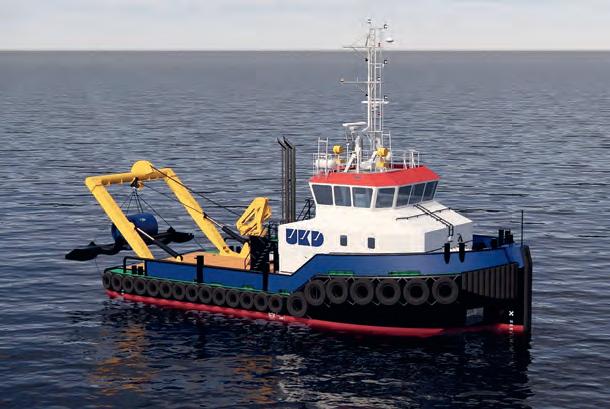
Orders keep coming in
Following Purus Wind's acquisition of HST, three more FCS 2710 Hybrids were contracted at the end of 2022. An even larger follow-up order followed in March last year for eight new vessels: four Damen FCS 2710 Hybrids, three FCS 3210 Hybrid CTVs, and one 90-metre Construction Service Operation Vessel (CSOV). The FCS 3210s and the CSOV are equipped for ultra-low emission operations and have been designed to be upgraded to methanol-fuelled engines when the time comes. The order is part of Purus Wind's strategy to be a leading provider of low-carbon, offshore wind support vessels. The FCSs were initially built at the Damen yard in Singapore, but nowadays mainly at its yard in Turkey. The CSOV will be built in Vietnam. According to Van der Linde, the order also contributes to Damen's aim of becoming the most sustainable shipbuilder itself. Meanwhile, Damen also builds in the UK together with Coastal Workboats in Exeter, Devon. Two years ago, this allowed the UK yard to deliver a so-called Landing Utility Vessel (LUV) 2208 to an operator of salmon fish farms in Scotland's Western Isles. An LUV has a large deck space for fish cages and nets. An LUV order has now also been booked from Penzance-based (Cornwall) Isles of Scilly Steamship Group, which will operate it as a freight vessel around the Isles of Scilly. Damen plans to have the yard in Exeter build two more LUVs on stock.
In August last year, Damen signed a contract with UK Dredging for the delivery of a Shoalbuster 2711 Water Injection Dredger (WID). Based on a proven design, the vessel nonetheless represents a unique and innovative approach to water injection dredging. UK
Dredging, part of Associated British Ports (ABP), operates Britain’s largest dredging fleet. It already has a number of Damen dredgers and workboats, including two Multi Cat Plough Vessels. The company undertakes maintenance dredging in ABP’s ports, for which it typically operates a number of hopper dredgers. The WID will enable the company to extend the intervals in between hopper dredging operations, thereby considerably increasing efficiency.
The yard of Damen Hardinxveld is currently finishing two Damen multi-purpose Shoalbusters 2208 for Cory, one of the UK’s leading waste management and recycling companies, The vessels will be used to manoeuvre the barges that transport waste down the River Thames to Cory’s sorting facilities for either recycling or energy recovery. The new vessels will join four Shoalbusters 2208S that Cory Group bought ten years ago for the same purpose. They will look similar to their counterparts, but will feature a wide range of updates and upgrades. These include being IMO Tier III compliant with compact selective catalytic reduction systems fitted to fuel-efficient MAN engines to minimise NOX emissions. The fender arrangement is also being upgraded to provide all-round protection to the topsides as they manage their barges.
‘This way, we built a longstanding relationship with our clients and the wider industry,’ Van der Linde states. ‘It’s always a joy to travel to the UK and cooperate closely on all sort of projects. We seem to have a lot in common, have nice conversations and know how to find each other.’
Seawork exhibition
The Seawork show will have its 25th anniversary this year, where Damen will welcome its returning customers and relations with as much enthusiasm as 25 years ago. Many starting companies and captain-owners have visited the show and even purchased their first Damen workboat on the spot.
Unlike last year, when the X01 Patrick Blackett was moored at the Mayflower Park jetty during Seawork as a showcase of Damen's capabilities, there will be no full-size Damen ships on display. Van der Linde: ‘Over the last few years, we always managed to bring ships. And we did try this time too, but the workboat market is doing very well now, and all available tonnage is needed.’
Priority for Van der Linde at the show is to show the progress Damen has made in making its vessels more sustainable. ‘For the FCS 2710 for example, we are looking at whether we can get a methanol option ready. We have calculated that the space for the tanks is there. All this fits into our roadmap to eventually get to delivering zero- emission ships,’ concludes Van der Linde.

Antoon Oosting
Freelance maritime journalist and SWZ|Maritime’s editor-in-chief, swz.rotterdam@knvts.nl
21 SWZ MARITIME • MAY 2024
UK Dredging ordered a Shoalbuster 2711 Water Injection Dredger. Although based on a proven design, it represents an innovative approach to water injection dredging.
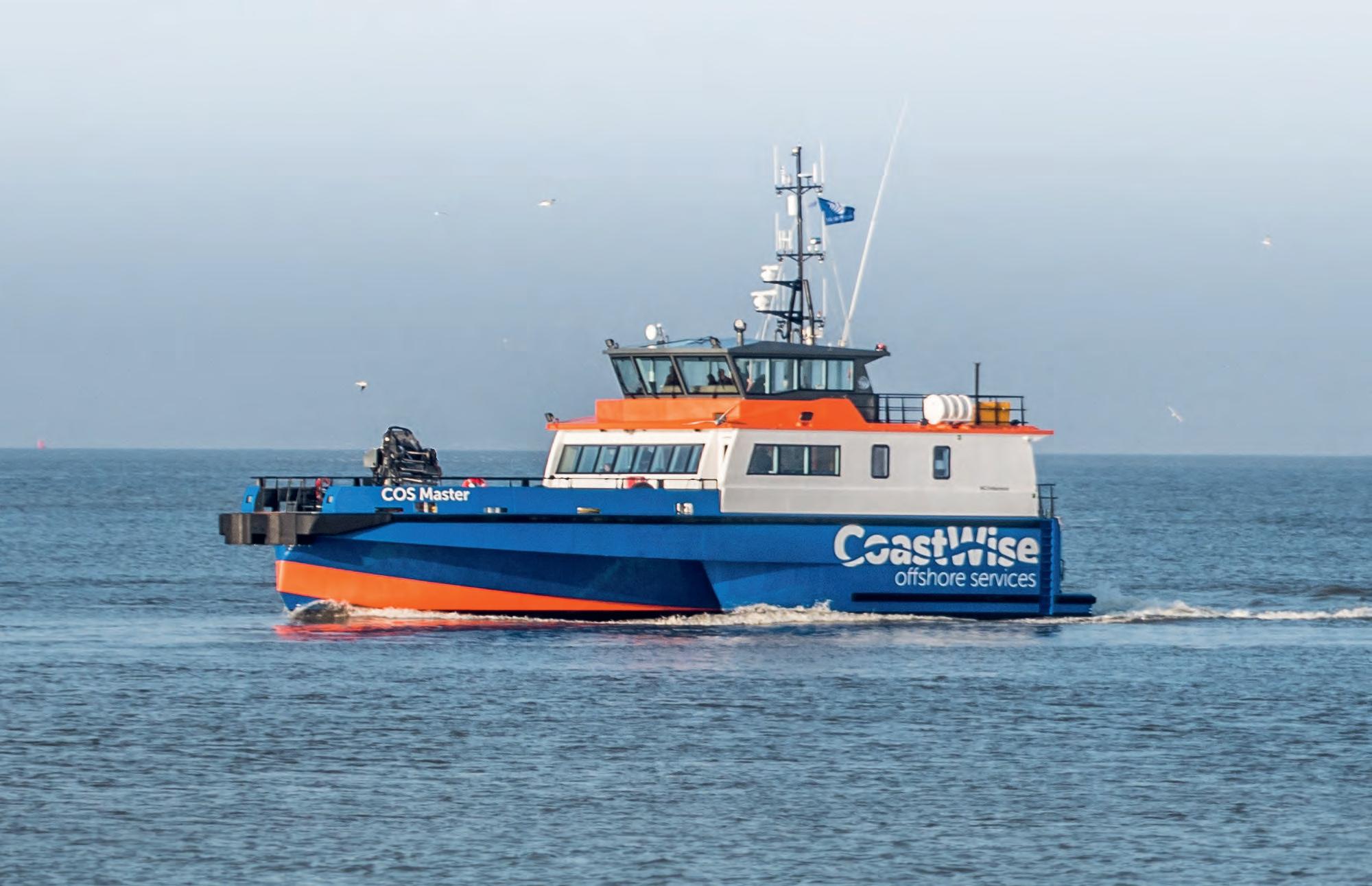
NG-DESIGNED MONOMARAN CREW TENDERS SAVE FUEL
Next Generation Shipyards BV (NG Shipyards), located at the outer port of Lauwersoog since April 2014, designs, builds, repairs and maintains workboats up to 35 metres. For account of Coastwise, NG Shipyards recently delivered three innovative crew tender vessels (CTVs).
The yard was established by owner/director Albert Keizer. Son Dirk Keizer has been strengthening management as a second owner/director since 1 January 2022. Innovation and sustainability are top of mind and the yard continues to search for durable applications and technologies to reduce its ecological footprint. The further development of the yacht Ecolution on behalf of the late Wubbo Ockels is one example of this commitment. For 24/7 repair and maintenance, a shiplift with a lifting capacity of 242 tonnes is available for vessels with a beam of up to 10 metres. NG Shipyards builds survey/research/hydrographic vessels, crew tenders for the offshore wind industry, pilot vessels and harbour support patrol vessels for account of among others Dutch Pilots, Rotterdam; Zeeland Seaports, Terneuzen; NIOZ, Texel; Geo Plus, Scheemda; Jan De Nul, Aalst; and Braveheart Shipping, Urk. The order backlog includes three M-class pilot tenders (as part of an order for a series of five, including the protoype Mira) for the
Dutch Pilots, one pilot tender for Milford Haven Port Authority and a Wadden Sea Taxi for AG Reederei Norden-Frisia.
Coastwise orders crew tenders
Coastwise Offshore Services BV was established in 2002 as a traditional captain/owner shipping company by captains/owners Eelko Wijdieks and Douwe van den Berg. They have gained years of experience on board low air draught sea/river vessels, multi-purpose vessels, container ships and with the transportation of various types of cargo.
At a later stage, the captains combined their knowledge for the design of a new type of energy-efficient and fuel-saving aluminium crew tender, a monomaran with two side supporting hulls. The crew tender was designed by NG Shipyards in close cooperation with naval architect Fred van Dorresteijn (VDD-Design), Dordrecht. Coastwise contracted NG Shipyards for the construction and delivery of
The three aluminium monomaran crew tenders that NG Shipyards built for Coastwise Offshore Services.
22 SWZ MARITIME • MAY 2024 SHIP IN DETAIL
tender
Name Imo Yard number Keel laid Launched Delivered COS Mate 9929417 NGS-33 30-09-2021 20-08-2022 01-11-2022 COS Master 9929405 NGS-34 30-11-2020 09-11-2021 20-12-2022
NGS-36 28-06-2022 25-02-2023 24-03-2023
Photo: The COS Master was the second crew
to be delivered to Coastwise in 2022 (all photos by NG
Shipyards).
COS Mariner 9972294



















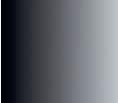










23 SWZ MARITIME • MAY 2024
SHIP IN DETAIL
The shiplift being used to launch the COS Mariner.
SPECFICATIONS OF THE CREW TENDER NG ENDURANCE 2727
Dimensions
Length over all: 27.27 metres
Length hull:
Length waterline:
Length loadline:
Beam over all:
Beam hull:
Depth:
metres
metres
metres
metres
metres
metres
Draught: 1.80 metres
Tonnage:
232 GT, 136 DWT
Full displacement: 136.9 tonnes
Fresh water capacity: 40 00 litres
Sewage capacity: 240 0 litres
Propulsion
Two MAN diesel engines with optimal power/weight ratio, type D2862 LE 489 (128 x 157), total output 2162 kW or 2896 hp at 2100 rpm, with exhaust gas aftertreatment and selective catalytic reduction (SCR), AdBlue, IMO Tier III/ETP Tier 4, via two Servogear, type HD295H, gear boxes (3.3 : 1) on two controllable pitch propellers with a diameter of 1325 mm for a service speed of 25 knots (maximum 27 knots). The bollard pull @ 100% maximum continuous rating (MCR) is 20 tonnes, @ 80% MCR 17 tonnes or @ 47% MCR 12 tonnes. The Endurance 2727 has two electrical bow thrusters. The bunker capacity is 40.52 m3, AdBlue capacity 2000 litres for a range of 1500 nm. Engines and auxiliary engines can run on hydrotreated vegetable oil (HVO) fuel, which will result in CO2 emissions reductions of as much as 90% while emissions of SOX, NOX, and particulate matter are also considerably lower. A heat recovery system is also installed.
Cargo capacity
The cargo deck area has a surface of 67 m2 with a maximum allowable load of 1.5 tonnes/m2 or 1x 20ft-container in longitudinal direction, 15 tonnes total weight, or 1x 20 ft abeam, 22 tonnes total
weight, or 1x 20 ft + 1x 10 ft, 10 tonnes total weight or 1x 10 ft, 15 tonnes total weight. The Endurance 2727 is equipped with a foldable Melcal deck crane, type F15T3 with a safe working load (SWL) of 2000 kgs at 5 metres or 910 kgs at 10.5 metres. Optionally, the vessel can be equipped with an A-frame on the stern deck with an SWL of 1500 kgs, outreach about 2 metres to the aft and 1 metre to the forward direction from rotation point.
Other features
• Integrated moonpool with a diameter of 70 0 mm.
• 19 inch rack space.
• Flag: Netherlands
• Classification: Bureau Veritas I X +Hull Mach Lightship/CTV High speed offshore service vessel Sea area 3, AUT
Accommodation
The multipurpose pax area is equipped with coffee bar, video system and Wi-Fi. The pax area can be configured in multiple layouts:
• 30 IP configuration.
• Conference configuration.
• Sur vey configuration.
• Medical first aid area.






• Dedicated workstation for two surveyors on the bridge. For larger projects, the pax area can be configured in a survey setting.
Deployment
The NG Endurance 2727 can also be deployed for:
• Route surveys of pipelines, cables and renewables combined with crew transfer if required.
• Seabed mapping
• Inspection sur vey.
• Ser vices for dredging.

24 SWZ MARITIME • MAY 2024
IN DETAIL
SHIP
26.25
25.45
23.98
9.80
9.60
4.85
the first vessel on 27 August 2020. The order included an option for three more vessels with each vessel representing an investment of € 5 million.
At the same time, Coastwise Offshore Services’ operational management, which was executed by both owners, was strengthened by Onno Nienhuis from the small fishing village of Zoutkamp as managing partner. Nienhuis has strong maritime ties and is an experienced entrepreneur and investor, active in fishing, real estate and ship finance. Construction of the tenders started on 30 November 2020 and between 1 November 2022 and 24 March 2023, they were delivered as COS Mate, COS Master and COS Mariner. Coastwise Offshore owns a fleet of three crew transfer vessels for deployment in the offshore wind and oil and gas industry. These tenders are suitable for short-term and long-term crew transfer, support and survey purposes. Coastwise consists of the following


companies: Coastwise Management BV, Rederij Coastwise VoF, Coastwise Crewing BV, Coastwise Offshore Services BV, Culemborg. Both owners still sail as masters. For the rest of the crew, depending on the project, they have their own pool of experienced professionals. Commercial management of the vessels has been assigned to SeaZip Offshore Service BV, Harlingen.

Design of the NG Endurance 2727

The aluminium crew tenders are of the NG Endurance 2727 design. This design has a CFD-optimised (computational fluid dynamics) aluminium hull and superstructure. It has competitive advantages such as more comfort, good seagoing characteristics and a high level of fuel efficiency due to its optimised hull form. The monomaran hull design consists of three hulls; one middle centre hull and two side supporting hulls and a cross structure. The NG Endurance 2727 combines the advantages of a monohull (smooth roll and better seakeeping behaviour) with the advantages of a catamaran (lower resistance, a higher speed compared to the same installed power, improved ability, more stability and less deadweight). Accommodation is provided for a maximum of five crew and 31 passengers (industrial personnel).
The wheelhouse provides total control and complete visibility during operations. As a result of this, the NG Endurance has an allround view for the captain. Under all weather conditions, the NG Endurance can be sailed and manoeuvred by a single person due to the one-man bridge control system Navigator. The vessel is allowed to sail up tot 100 nautical miles from the coastline and is suitable for heavy-duty use in bad weather under severe sea conditons. The NG Endurance is highly manoeuvrable at full speed as well as alongside a ship/quay or against a pole. It provides a safe embarkation and disembarkation of crew and industrial workers in ship-to-ship operations or ship-to-wind turbines in seas of up to 2.5 metres significant wave height.
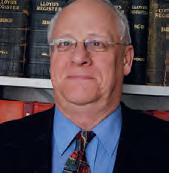
Gerrit de Boer
Has been a maritime author for over fifty years and is one of SWZ|Maritime’s editors, gerritjdeboer@kpnmail.nl
25 SWZ MARITIME • MAY 2024 SHIP IN DETAIL
The NG Endurance 2727 design has a CFD-optimised aluminium hull and superstructure.
NG Shipyards also builds pilot vessels, such as the Mare, second of the M-class, for the Dutch Pilots.

NAUPLIUS BUILDS BOATS FOR SCOTTISH FISH FARMING
Nauplius Workboats BV, Groningen (city), was established by Jaap van den Hul and Gerrit Knol in 2006 to design, build and deliver all kinds of vessels for the commercial, industrial and aquaculture sector. This includes utility vessels, landing utility vessels, crew transfer/survey vessels and flattop barges. In-house engineering company Argos Engineering BV designs the vessels.
Over the last ten years, Nauplius designed and delivered special utility vessels for the fish farming industry (mostly salmon farms). These are deployed up to 60 miles from shore in the turbulent Atlantic along Scotland's north-west coast around the Hebrides and Isle of Mull, in Loch Linnhe, and also in northern Scottish waters around the Orkney and Shetland Islands. The vessels are available in different designs and sizes such as Utility Vessels 3514, 2713, 2109 and 1507, and Landing Utility Vessels 2712, 2108, 1907 and 1807, equipped with a hydraulically driven bow ramp. In addition, Nauplius also delivered a 2511 Hydrolicer Barge. The largest Utility Vessel that Nauplius has built so far, also the world's largest thermolicer, is the 3514 UV Camilla Eslea (464 GT), which was delivered on 8 September 2021 to Inverlussa Marine Services, Craignure, Isle of Mull. The first workboats were landing craft designs with aft wheelhous-
es. The second-generation boats have forward-wheelhouses and the next were the newly-designed hybrid boats that are a combination between a landing craft and multicat vessel with side accommodation and wheelhouse. Nauplius entered into contracts with Scottish aquaculture ventures, providing them with a variety of support services for their salmon farms, including delousing treatments using peroxide and non-peroxide methods, maintenance of complete mooring grid installations, net changing and barge towage.
Two hybrid aquaculture service vessels
Nauplius Workboats delivered two hybrid aquaculture service vessels of type 2713 UV, the Eloise Eslea and Isaac Eslea to Inverlussa Marine Services, Craignure, Isle of Mull, in 2022 and 2023. This 2713 UV is designed as a delousing vessel capable of supporting a delousing system with a throughput of 200 tonnes per hour. The vessel
26 SWZ MARITIME • MAY 2024
SHIP
IN DETAIL
Name Imo Yard number Launched Delivered Eloise Eslea 9969572 N022 08-10-2022 25-11-2022 Isaac Eslea 9969584 N023 04-03-2023 15-04-2023
Photo: Camilla Eslea is the largest Utility Vessel that Nauplius has built so far and the world's largest thermolicer (all photos by Nauplius).
IN DETAIL
2713 UTILITY VESSEL







Propulsion and energy supply
3x main generators Mitsubishi S6R2-T2MPTK (170 x 180), 3 x 640 kW at 1500 rpm, Newage Stamford S6LLLLM-C4, output 3 x 690 kW (762 kVA) @ 400 V –50 Hz, coupled via a PMS system and battery pack (316 kWh), bollard pull 50 tonnes
Harbour generator: 1x Volvo Penta D5A-T Newage Stamford UCM274 D output 79 ekW (87.5 kVA)@50 Hz
Main propulsion: 2x azimuth thrusters Veth L-Drive, type VL-400si output 2 x 500 ekW
Bow thruster: Veth Propulsion VT 240 output 250 ekW in tunnel
Auxiliary equipment
• 3x deck cranes HS Marine type AK 48/18.5 E5 with a safe working load (SWL) of 1100 kgs at 18.55 metres (2 starboard + 1 portside)
• 1x HS Marine t ype AK 20
• 6x hydraulically driven Capstans Tenford Industry N300-5000
• Treatment equipment consists of twin triple vacuum pumps and twin drum filters.
-2 0 2 4 6 8 10 12 14 16 18 20 22 24 26 28 30 32 34 36 38 40 42 -2 0 2 4 6 8 10 12 14 16 18 20 22 24 26 28 34 36 38 40 42 Changing SOS locker DN UP Pumproom Galley integrated full height fridge Oven/Oven shelves dishwasher cable trays piping all navcom alarms etc. Clean bunt, drum filter DN UP HDR TNK BTR drain -2 0 2 4 6 8 10 12 14 16 18 20 22 24 26 28 30 32 34 36 38 40 42 Fuel tank Freshwater tank Ballast water tank Ballast water tank Ballast water tank Ballast water tank UP 2P Cabin Freshwater tank Freshwater tank Fuel tank Fuel tank Height 1350 ab Height 1350 ab Ballast water tank Ballast water tank Fuel day oil tank Overflow tank Sewage tank Bowthruster room Fore peak UP Hyd. oil tank Dirty oil tank Airduct Harbour generator L-drive bilge bilge sounding, keep free manhole manhole battery battery battery battery battery Frequency panel panel panel panel High pressure cleaner UP -2 0 2 4 6 8 10 12 14 16 18 20 22 24 26 28 30 32 34 36 38 40 42 UP DN DN UP Wetunit Motorman Mate plotter monitor Control Room sink, fridge padded Store dry changing room app. 6,4 m Skipper 26 28 30 32 34 36 38 DN DN DN 26 28 30 32 34 36 38 Contract version 15-11-21 DRAWING NUMBER: Koldingweg 3 9723 HL Groningen the Netherlands Tel: + 31 (0)50 577 13 25 Fax: + 31 (0)50 577 10 05 E-mail:info@naupliusworkboats.com Website: www.naupliusworkboats.com NAUPLIUS WORKBOATS A0 1:50 Argos Engineering B.V. 25-02-2022 2713 Utility Vessel 023000000Bi.p.
deck Maindeck Tanktop Wheelhouse
updated acc. MD lay-out updated xx-xx-22 Bip Removed shelterdeck re-arranged acc. A MAIN PARTICULARS: Dimensions: Length overallabt.: 26,95 meter Length rule 23,99 meter Breadth overallabt.: 13,50 meter Breadth hullabt.: 13,00meter Depth abt.: 3,50meter Draft abt.: 2,75meter Gross Tonnage: <200 GT Air draft abt.: 17,00meter National Authority: United Kingdom Scotland Category 1 (150Nm from safe haven) Radio Area GMDSS A2 Capacities: Ballast waterabt.: 85m³ Fuel oil abt.: 65m³ Fresh waterabt.: 64m³ Sewage waterabt.: 3m³ Lub. oil tankabt. : 1 m³ Dirty oil tankabt. : 1m³ Propulsion: Main generator3x: Mitsubishi S6R2-T2MPTK 640 kW @ 1500 rpm Newage Stamford S6LM-C4 610 ekW (762 kVA) @ 400V - 50 Hz Harbour generator1x Volvo Penta D5A-T Newage Stamford UCM 274 D 70 ekW (87,5 kVA) @ 50 Hz Main Propulsion2x: VETH L-Drive VL-400si 500 ekW Auxiliary equipment Thrusters1x: Veth Propulsion VT 240 250 ekW Deck cranes3x: HS Marine AK 48/18,5 E5 1100 kg @ 18,55 meter 1x: HS Marine AK 20 Capstan6x: Tenford Industry N300-5000 Hydraulic driven 12 14 16 18 20 22 24 26 28 30 32 34 36 38 40 42 Fuel tank tank UP Foldable bed above 2P Cabin 2P Cabin Provision store Freshwater tank Height 1350 ab Ballast water tank Sewage tank Bowthruster room Fore peak UP Hyd. oil tank Lub. oil tank Airduct Main generator bilge well Local and remote sounding, keep free manhole manhole motion control Alarm panel ER panel Fi-fi bilge pump panel control panel 600x1380x205 Hydraulic pump Starter panel Hydraulic pump Hydraulic pump control panel Starter panel Contract version 15-11-21 0 DRAWING DESCRIPTION: THIS IS AN CAD DRAWING AND MUST NEVER BE CHANGED BY HAND, DNR2005 CONDITIONS APPLICABLE COPYRIGHT RESERVED BY NAUPLIUS WORKBOATS DRAWN BY: DATE: SHEET No: TOTAL SHEETS: PROJECT No:AREA Nr:DRAWING No:REV. No: SIZE: SCALE: DRAWING NUMBER: -POS No. AMOUNT DESCRIPTION. MATERIAL. DIMENSION. REMARKS. REV. No. MODIFICATION. DATE Koldingweg 3 9723 HL Groningen the Netherlands Tel: + 31 (0)50 577 13 25 Fax: + 31 (0)50 577 10 05 E-mail:info@naupliusworkboats.com Website: www.naupliusworkboats.com NAUPLIUS WORKBOATS A0 1:50 Argos Engineering B.V. 25-02-2022 2713 Utility Vessel 023000000Bi.p. 1 1 updated acc. MD lay-out updated xx-xx-22 Bip Removed shelterdeck re-arranged acc. 19-04-22 A : VL-400si : 500 ekW Auxiliary equipment Thrusters1x: Veth Propulsion VT 240 : 250 ekW Deck cranes3x: HS Marine : AK 48/18,5 E5 : 1100 kg @ 18,55 meter 1x: HS Marine : AK 20 Capstan6x: Tenford Industry : N300-5000 : Hydraulic driven 27 SWZ MARITIME • MAY 2024
2713 UV SHIP DESIGN Length over all: 26.95 metres Length rule: 23.99 metres Breadth over all: 13.50 metres Breadth hull: 13.00 metres Depth: 3.50 metres Draught: 2.87 metres Air draught: 17.00 metres Tonnage: 197 GT Class: National authorit y UK / Scotland Catagory 1 (150 Nm from safe haven) Tank capacities Ballast water: 85 m³ Fuel oil: 65 m³ Fresh water: 64 m³ Sewage water: 3 m³ Lube oil t ank: 1 m³ Dirt y oil tank: 1 m³
Forecastle
HYBRID
SHIP
SHIP IN DETAIL
Beinn Eibhne
1807LUV Marine Harvest (Scotland)
Beinn Airein 2014 1807LUV Marine Harvest (Scotland)
Beinn Fhada 2014 1907LUV Marine Harvest (Scotland)
Bain Scorabhaig NO01 2016 1507UV Marine Harvest (Scotland)
Bain Mohr NO02 2016 1507UV Marine Harvest (Scotland)
Beinn Bhan NO03 2017 2511 HB Marine Harvest (Scotland)
Sandoyne Lass NO04 2017 1507UV Scottish Sea Farms
Beinn Dearg NO06
Beinn Bhreac NO07
Beinn Nibheis NO08
Askival NO09
Beinn Na Caillich NO10
Fair Isle NO11
Mowi Supporter NO12
Beinn Mowi NO14
Beinn An Oir NO15
Mowi Atlantic NO16
Naomi D NO17
Mowi Tuath NO18
Ella May NO19
Camilla Eslea NO21
Eloise Eslea NO22
Isaac Eslea NO23
Arthur Douglas NO24
TBD NO25
2712LUV DESS
2712LUV DESS
2712LUV DESS
1907LUV Marine Harvest (Scotland)
(Scotland)
(Scotland)
(Scotland)
Marine Harvest (Scotland)
Mowi
2109LUV Inverlussa Marine Services Ltd.
TBD NO26 2024 FB 400T Gael Force
of
Nauplius Workboats.
is diesel-electric with a dynamic positioning (DP) system, which ensures safe working and sailing around fish pens.
Special attention has been given to the noise levels on board so that the highest noise notation of class can be met. The accommodation with five single cabins, all fitted with bunk beds, and optional six cabins and smaller office, has an all-round view wheelhouse. With a conning station forward and aft, it is ready to take on almost any job at sea. A special feature is the heat recovery system with a maximum capacity of 800 kW and an electrical power outlet of 1700 kW. The Utility Vessels can also be equipped as maintenance, service,
Has been a maritime author for over fifty years and is one of SWZ|Maritime’s editors, gerritjdeboer@kpnmail.nl Name

diving support, or survey vessel or deployed in oil spill recovery, harbour support or inspection or other tasks in the fishing industry.
Steel feed barges
Nauplius Workboats and the Scottish Gael Force Group, Inverness, signed a long-term international exclusive agreement for the construction of Gael Force’s range of steel feed barges on 15 December 2023. Gael Force Group is an established partner in the supply of equipment, technology, and services for the farming and catching of seafood. As part of the agreement, Nauplius received an initial order for the construction of two 400-tonne SeaFeed barges in Groningen. Once completed, the vessels will be towed to Inverness for full mechanical and electrical outfitting and installation of the SeaFeed system by Gael Force.

Gerrit de Boer
28 SWZ MARITIME • MAY 2024
Yard number Built Type Client
2014
2019
2019
2019
2018
2019 1907LUV Marine Harvest
2020 2109UV Scottish Sea Farms
2020 1907LUV Marine Harvest
2020 1907LUV
Marine Harvest
2020 1907LUV
2020 1907LUV
2020 1507UV
Cooke Aquaculture Scotland
2020
1907LUV Mowi
2020 1507UV
Cooke Aquaculture Scotland
2021 3514UV
Marine Services Ltd.
Inverlussa
2022 2713UV
Inverlussa Marine Services Ltd.
2023
2713UV Inverlussa Marine Services Ltd.
2024
2024 FB 400T Gael Force
List
vessels delivered by
LUV = Landing Utility Vessel, UV = Utility Vessel, HB = Hydrolicer Barge, FB = Feed Barge.
The Eloise Eslea was built for Inverlussa Marine Services.
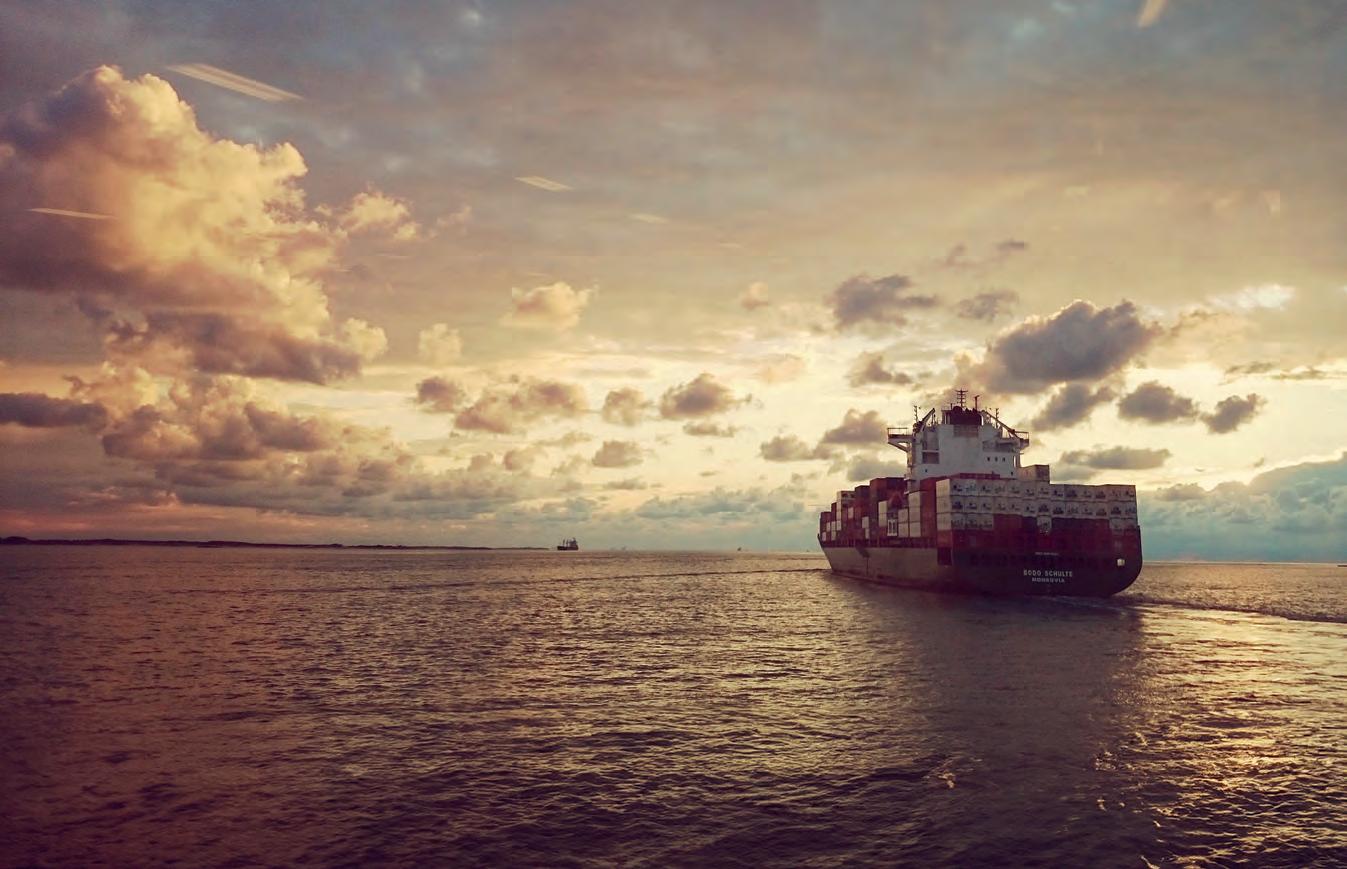
THE EU AND THE DECARBONISATION OF SHIPS
Slowly, slowly phasing out fossil fuels and introducing low-carbon fuels
The European Green Deal from 2019 emphasises the need to accelerate the transition to a lowemission and climate-neutral economy and underlines that all sectors will need to contribute, including shipping. For shipping, the European Union has implemented or will implement five instruments.
Before the EU’s Green Deal and ”Fit for 55” programme, in 2015, the EU proposed the so-called EU-MRV directive, the “Regulation on the monitoring, reporting and verification of CO2 emissions from maritime transport”. This regulation came into force in 2018 and requires ships above 5000 GT to report on their annual CO2 emissions and other relevant information. This was the EU’s first step to get to grips with the CO2 emissions of ships. From 2024, the EU-MRV will also require the reporting of CH4 and NO2, as CO2 equivalent emissions. From 2025, the EU-MRV will be extended to cover general cargo and offshore vessels from 400 GT. The EU-MRV paved the way for the implementation of the various other EU instruments subsequently introduced.
For shipping, the European Union has now come up with five instruments to meet the goals of the European Green Deal. These are:
• FuelEU Maritime: A directive aimed at the reduction of the greenhouse gas (GHG) intensity of the energy used on board of ships. Applicable from 1 January 2025 and described in this article.
• The EU Emissions Trading System (EU-ETS): Applicable since 1 January 2024 and described in the January 2024 edition of this magazine.
• The Renewable Energy Directive (REDIII): A revision of an exist-
ing directive aimed at increasing the availability of renewable fuels with an obligation for fuel traders to deliver a determined amount of renewable fuel to transport. Briefly described in this issue, see text box.
• The Energy Taxation Directive (ETD): A revision of an existing directive aimed at adding fuels for shipping to the fuels already charged with excise duty. Understood to be still under discussion, no details known.
• The Alternative Fuels Infrastructure Regulation (AFIR): A revision of an existing directive, aimed at the realisation of an energy charging and tank infrastructure for mobility including a requirement to have shore power available in seaports. AFIR requires that from 2025, member states must have a suitable number of LNG bunker facilities available in the so-called “TEN-T core maritime ports” enabling seagoing ships to operate through this network of ports on LNG. Another target is to have provisions for shore power facilities in all large EU ports from 2030.
FuelEU Maritime
The European Commission has launched the FuelEU Maritime initiative (Regulation for the use of renewable and low-carbon fuels in
29 SWZ MARITIME • MAY 2024 RUBRIEK REGULATIONS
Photo: From 2024, under the EU-MRV, ships also have to report CH4 and NO2 emissions, as CO2 equivalent emissions.
RUBRIEK REGULATIONS
maritime transport) to increase the share of sustainable low and zero-carbon alternative fuels in the fuel mix of maritime transport.
FuelEU Maritime is part of the EU’s “Fit for 55” package and will be in force as of 2025.
The EU-MRV paved the way for the implementation of the various other EU instruments
The FuelEU regulation applies, with a few exceptions, to merchant ships with a tonnage above 5000 GT. Ships above 5000 GT are claimed to be responsible for approximately ninety per cent of CO emissions from ships calling at EU ports. Eventually the Regulation may be extended to ships below 5000 GT. The rules apply to ships regardless their flag. The entity responsible for ensuring compliance with this regulation is the company that has assumed responsibility for the vessel's operation as laid down in the IMO regulations. The objective is the uptake of renewable and low-carbon fuels and the application of substitute sources of energy by ships, such as wind power systems.
FuelEU will be applicable from 1 January 2025 and in that year, the average greenhouse gas (GHG) intensity should be two per cent below the average GHG intensity of the EU fleet in 2020. The reference value amounts to 91.16 grammes of CO2 equivalent per MJ of used fuel. The regulation is goal-based with the limits set on the GHG intensity of the energy used on ships without prescribing the use of any particular fuel or technology. The regulation establishes the methodology and the formula for the calculation of the yearly aver-

Figuur 5 Verplichte percentages voor de reductie van de broeikasgasintensiteit (“well-to-wake”, WTW) van de energie gebruikt aan boord van schepen op jaarbasis ten opzichte van de referentie in FuelEU Maritime (Lloyd’s Register, 2023)
Mandatory percentages for reduction of greenhouse gas intensity ("well-to-wake", WTW) of energy used on board ships on an annual basis compared to the baseline in FuelEU Maritime (Lloyd's Register, 2023).
Scheepseigenaren mogen zelf kiezen waar ze willen bunkeren (binnen of buiten de EU) en met welke energiedragers ze de reductiedoelen willen behalen. Hiervoor kunnen ze hernieuwbare energiedragers inzetten zoals biobrandstoffen, biogas en hernieuwbare brandstoffen van niet-biologische oorsprong (Renewable Fuels of NonBiological Origin, RFNBOs; dit zijn dit zijn synthetische brandstoffen op basis van hernieuwbare elektriciteit, waaronder hernieuwbare waterstof) Ook energiedragers gebaseerd op fossiele bronnen met een lage(re) broeikasgasintensiteit kunnen bijdragen, net als gerecyclede koolwaterstoffen (Recycled Carbon Fuels, RCF s). Daarnaast mag bij de berekening van de jaarlijkse gemiddelde broeikasgasintensiteit van de energie gebruikt aan boord een beloningsfactor worden toegepast indien een schip gebruik maakt van windenergie bij de voortstuwing ( “wind assisted propulsion”).
age GHG intensity of the energy used on board of a ship. It will be assessed on a well-to-wake basis, accounting for the impacts of energy production, transport, distribution and use on board. The limits set for lowering GHG emissions should be expressed in terms of “CO2 equivalent” meaning that CO2, CH4 and NO2 emissions are all to be included. The EU will establish an electronic database that registers the performance of each ship, the “FuelEU Database”.
Pooling performance
In Annex II van de FuelEU Maritime verordening zijn voor de verschillende energiedragers standaardwaarden (“default values”) opgenomen voor de broeikasgasemissies, zowel voor het “well-to-tank” (WTT; emissies in de brandstofketen) deel als het “tank-to-wake” (TTW, uitlaatemissies) deel. Voor alle energiedragers - met uitzondering van fossiele brandstoffen voor de WTT broeikasgasemissies en de TTW CO2-emissies - mogen ook eigen berekende waarden (“actual values”) worden gebruikt, mits aan de daarvoor geldende (certificerings)eisen is voldaan.
Companies are allowed to “pool” the performance of different ships. That enables the over-performance of one ship to compensate the under-performance of other ships, provided that the total pooled compliance is positive. Ships that do not meet the limits on the yearly average GHG intensity are subject to a penalty. This FuelEU penalty will be based on the amount of and cost of renewable
THE RENEWABLE ENERGY DIRECTIVE (REDIII)
The original directive was introduced in 2009. Since then, the share of renewable energy sources in EU energy consumption has increased from 12.5 per cent in 2010 to 23 per cent in 2022. The revised directive (2023) has to be implemented by member states by 1 January, 2025, and also applies to maritime transport. The member states have a lot of freedom when implementing this directive into national laws and regulations. The objectives are not fully in line with those from the FuelEU Maritime Directive. The member states have the freedom to determine the required GHG reduction for the different transport sectors. This may lead to differences between countries. According to REDIII, the share of renewable energy sources in the total energy consumption for the whole of the EU shall by 2030 be increased to 42.5 per cent, supplemented with an additional voluntary increase aimed at achieving 45 per cent. All member states have to contribute to reach this goal. Besides these general targets, there are objectives for specific economic activities such as for transport. REDIII requires that
Biobrandstoffen, RFNBOs en RCFs moeten, om bij te mogen dragen aan de reductiedoelen, aan de duurzaamheids- en broeikasgasemissie-eisen uit de RED (zie 0) voldoen. Voor de borging hiervan door middel van certificering bouwt FuelEU Maritime ook voort op de systematiek van de RED met door de Europese Commissie erkende certificeringssystemen (“voluntary schemes”) Brandstoffen die niet aan deze eisen voldoen, krijgen de emissiefactor toegekend van de minst gunstige fossiele brandstofroute voor dit type brandstof. Hetzelfde geldt voor biobrandstoffen
the share of renewable energy in all sectors of transport will be increased, leading to reduced GHG emissions. Member states should guarantee that the quantity of renewable energy available for transport complies with the following:
• A share of at least 29 per cent renewable energy in the energy consumption of transport in 2030, or
• A reduction of the GHG intensit y of fuels used by transport of at least 14.5 per cent in 2030.
• Member st ates are free to distinguish between different types of fuels and between maritime transport and other sectors.
REDIII requires that the share of synthetic fuels produced on the basis of green electric energy or hydrogen, such as RFNBOs (renewable fuels of non-biological origin), will be at least one per cent in 2025 and 5.5 per cent in 2030. For member states with seaports, an indicative target applies, which dictates that from 2030, the share of RFNBOs in the total amount of energy supplied to the maritime sector is at least 1.2 per cent.
14
30 SWZ MARITIME • MAY 2024

RUBRIEK
REGULATIONS
and low-carbon fuels that the ship should have used to meet the requirements of the regulation. Such a penalty will also be imposed for non-compliant port calls. It is understood that the cost of noncompliance could be about € 2400 per tonne non-compliant fuel. The annual average GHG intensity of the energy used on board a ship during a reporting period shall be reduced from the reference value of 91.16 grammes of CO2 equivalent per MJ in accordance with the targets and time schedule as depicted in the graph on the previous page.
Shore power and free choice of fuel
GHG emissions of the energy used by ships operating wholly between EU ports count for 100 per cent in this regulation whilst the emissions used by ships sailing from or to ports outside the EU count for only fifty per cent. The regulation also requires that container and cruise ships that stay longer than two hours in an EU port must use shore power (Onshore Power Supply, OPS), unless they use zero-emission technologies. This requirement is generally applicable from 2030 with some exceptions from 2035. Shipowners are free to bunker in or outside the EU and with what kind of fuels they want to achieve the required reduction targets. They may select renewable fuels like biofuels, biogas and renewable fuels of non-biological origin, so-called RFNBOs. These are synthetic fuels produced with green electrical energy or green hydrogen. Also, energy sources based on fossil fuels, but with a lower GHG intensity could contribute, just as recycled carbon fuels, (RCFs). When calculating the average annual GHG intensity, a reward factor may be applied in case the ship uses a form of wind-assisted propulsion.
GHG emission values
Annex II of the FuelEU Maritime regulation gives standard GHG emission values for various energy sources, so-called default values. Both for well-to-tank (WTT) and for tank-to-wake (TTW) emissions. Alternatively, actual values may be used provided these values have been properly certified.
Biofuels, RFNBOs and RCFs must comply with sustainability and GHG requirements specified in the EU Renewable Energy Directive (REDIII). Fuels that do not comply with these requirements get assigned the most unfavourable emission value for that kind of fuel. The same applies to biofuels that have been produced from food and feed crops.
For non-fossil fuels, the Bunker Delivery Note (BDN, according to MARPOL Annex VI) has to be completed with data regarding the GHG intensity and sustainability properties. In accordance with the rules of FuelEU for the period 2025 to 2033, the use of RFNBOs is stimulated by applying a multiplication factor of two for these fuels when calculating the resulting GHG reduction they produce. When in 2031 the share of RFNBOs still appears to be less than one per cent, a sub-target kicks in, requiring that from 2034, two per cent of the energy used on ships should be from RFNBOs. This requirement will not be applicable for ships using certain fuels with a comparable GHG intensity reduction capability.
Annex I to the FuelEU Directive describes the methodology for establishing the greenhouse gas intensity of the energy used on board by a ship. Annex II gives the default emission factors to be used for the determination of the GHG intensity index referred to in Annex I. Annex III identifies types of systems that may be considered zeroemission technologies, such as fuel cells, onboard electrical storage systems and onboard power generation systems such as wind and solar.

Ir Willem de Jong
Former Managing Director of Lloyd’s Register London and one of SWZ|Maritime’s editors, willem.dejong3@gmail.com
31 SWZ MARITIME • MAY 2024
Cruise ships that stay longer than two hours in an EU port must use shore power by 2030 (photo Frans Berkelaar, pxhere).
UNMANNED: AN ONGOING NAVAL TECHNOLOGY REVOLUTION
Over the course of recent years, a revolution has been underway on the modern naval battlefield. Ukraine has successfully been able to attack Russian warships using expendable unmanned surface vessels (eUSVs). Yet, unmanned solutions are not just being developed on the front lines. The technology is both cheap compared to manned alternatives and has a high operational impact.
On 1 February, a video surfaced on the internet of the sinking of the Russian Navy's Tarantul-II class corvette Ivanovets by the Ukrainian armed forces. This attack took place in Donuzlav Bay, at the heart of a Russian naval base. At nightfall, a swarm of eUSVs approached the ship from various directions, strategically targeting its exhaust outlet, engine room, propeller, and propulsion system with the aim of incapacitating the Russian vessel’s manoeuvrability and capability to avoid further attacks.
The use of these unmanned assets by the Ukrainian military has shown unprecedented success in the conflict. Documented operational use of Ukrainian surface drones currently includes the sinking of two landing craft at a Russian naval base in Chornomorsk in November 2023, as well as the recent sinking of both the Ivanovets corvette and the large landing ship Cesar Kunikov, all within the span of two weeks and in territories under Russian control. The eUSV model commonly used in these attacks is the Magura V5 – a multi-purpose unmanned surface vehicle capable of executing a wide array of missions and developed throughout the course of the Russo-Ukrainian conflict.
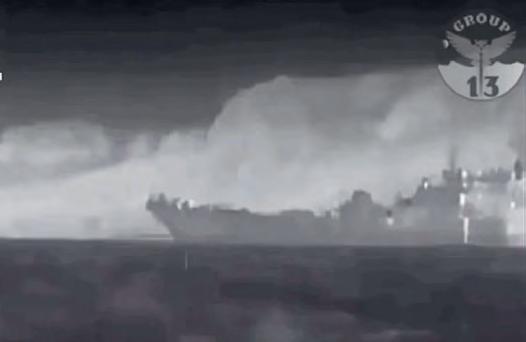
Considering the low acquisition cost of these unmanned surface vehicles (approximately US$ 273,000 per unit), their operational impact on the modern naval battlefield cannot be understated. Recently released footage of an attack on the Russian patrol ship Sergey Kotov has shown just how inadequately prepared the Russian fleet currently is in dealing with these threats – making this the thirteenth ship of Russia’s Black Sea fleet to be sunk or crippled and highlighting the operational value of offensive unmanned operations.
United States and Europe
Unmanned solutions aren’t solely being developed on the front lines, however. Just this past January, the United States based Defense Innovation Unit (DIU) released a tender for the rapid acquisition of small unmanned surface vehicle (sUSV) interceptors for operational area patrol and monitoring as well as intercepting maritime surface threats such as non-cooperative vessels. The Department of the Navy has signalled its strong interest in unmanned surface vehicles capable of operating in cohesive groups and performing complex manoeuvres and behaviours autonomously that adapt to the behaviour of the targeted surface threats. These USVs are intended to be production-ready, inexpensive and maritime expeditionary (PRIME) surface vehicles. This solicitation came as part of the Department of Defense’s Replicator programme as well as a large push on developing autonomous solutions for the United States Navy.
In Europe, meanwhile, a project for the acquisition of a multi-mission autonomous reference platform has already been underway since 2023 (EUROGUARD, EUROpean Goal based mUlti mission Autonomous naval Reference platform Development). This project aims to build a vessel capable of a range of different autonomous operations in coastal areas to contribute to rapid response capabilities by EU naval vessel fleets with advanced platform and weapon system technologies. This vessel, while still a demonstrator, will be able to carry several modular mission modules designed for a wide range of coastal operations. Currently, the project is being developed by a consortium of 23 companies led by Baltic Workboats (BWB), an Estonian shipbuilding company. Funding for the project
32 SWZ MARITIME • MAY 2024 NAVY
Infrared camera view of a Magura V5 USV attacking the Russian landing ship Cesar Kunikov (source: Ukraine Military Intelligence Agency (GUR)).
NAVY

comprises € 95 million, with € 65 million allocated directly from the European Defence Fund and € 30 million sourced from participating countries and industry.
China and the Russian state
Both China and the Russian state have also been making strides in naval autonomy. The Russian defence industry is developing a range of unmanned systems, of which surface vehicles are a substantial part. One of these products is the Vizir-700, a multi-mission unmanned surface vehicle developed by the Kingisepp MachineBuilding Plant (KMZ) holding company and the St. Petersburg State Polytechnic University, and currently entering production and testing stages. This small-sized USV has a length of 7.5 metres, a width of 2.4 metres, and a displacement of approximately 2 tonnes. The Vizir-700 is expected to reach speeds of up to 45 knots with a range at cruising speeds of up to 120 nautical miles. The USV is designed to carry a varying payload of up to 600 kg, which may include light weaponry, in order to combat enemy surface weapons (such as the Ukrainian Magura eUSVs).
China, meanwhile, has taken long strides in integrating surface autonomy into their naval arsenal as well as developing a wide range of new unmanned solutions. Not only are these assets being developed and tested at pace, but they have already seen operational deployment in recent years. In June 2022, China was already performing sea trials for a 200-tonne USV designed with stealth capabilities
and blue water operations in mind – and mimicking the design of the US-developed SeaHunter. In May of that same year, China launched another unmanned surface ship, the Zhu Hai Yun. This ship was designed as an uncrewed oceanography research vessel operating in open waters and serving as a mothership for other uncrewed vehicles – becoming commonly known as the first "drone mothership".
Ukrainian strikes highlight the operational value of offensive unmanned operations
More recently, at the World Defence Show Exhibition held between 4-8 February of this year in Riyadh, the China State Shipbuilding Company (CSSC) unveiled a new mediumsized USV concept: the Thunderer A2000. While still in the conceptual development stage, the Thunderer A2000, with a length of 45 metres and 280 tonnes, shows the potential for high operational relevance in littoral water warfare. This unmanned vehicle is armed with 24cell launchers capable of deploying loitering munitions as well as an 8-cell vertical launch system (VLS) compatible with short- and
33 SWZ MARITIME • MAY 2024
A US Navy autonomous surface naval vessel in San Diego (source: NWDC).
NAVY
medium-range surface-to-air missiles (such as the Chinese-made HQ-10). The ship is also equipped with an AESA radar for surface and air surveillance and is also capable of integrated unmanned vehicle operations, being able to control various smaller USVs as well as providing a platform for vertical take-off and landing (VTOL) unmanned aerial systems (UAS) operations.
Non-state actors
Large militaries and states have not been the sole entities making use of these technologies, however. On October 19, 2023, the Iranbacked Houthi movement launched a barrage of missiles and armed unmanned vehicles targeting the state of Israel. This event marked the start of the still ongoing Red Sea crisis, which has been continuously escalating and has recently drawn the intervention of various NATO member states. Within this crisis, unmanned vehicles have taken on a significant operational role – being employed by the Houthi movement to attack various targets in Israel, NATO warships, and even commercial vessels.
On 4 January, the Houthis launched a USV attack on a US Navy warship escorting commercial ships in the region. This attack was followed on 10 January by a large scale attack against a fleet of NATO warships, during which more than 21 UAVs and missiles were launched. This use of unmanned vehicles by the Houthi movement is not a recent development – particularly the use of eUSVs, which have been a key part of the Houthi naval weapons arsenal and have seen previous operational use against the Saudi coalition forces during the war in Yemen. The vehicles are likely assembled in Yemen from Iranian made components. These weapons are permissibly less expensive or technically complex to manufacture and deploy – making it so that militant and terrorist groups can easily produce, acquire, and employ these assets against allied forces.
Unmanned integration
Advances have been made in recent years not only in developing unmanned technologies, but also in integrating these assets into modern navies. As of 2022, the United States Navy has established a dedicated division aimed at accelerating the delivery of credible and reliable unmanned systems into the US Navy fleet, USDIV One. This division currently oversees medium and large unmanned surface vessel projects in the United States Navy, such as the Sea

A unified vision for both operational usage and implementation of unmanned assets is still lacking
Hunter and Sea Hawk. USDIV One serves as a cornerstone in building the knowledge to develop, integrate, operate, and maintain the growing US Navy’s fleet of unmanned surface assets. As of 2024, a second unmanned surface vessel division was also announced. This second squadron will focus on small USVs, building on the capacity of USDIV One – followed by the previously mentioned solicitation by the Defense Innovation Unit for small lethal surface vehicles within the Defense Department’s Replicator initiative. These efforts were followed by an integrated battle problem (24.1), aimed at the operational use of small USVs. In tandem, the US Navy has also announced a new rating in the field of Robotics Warfare. The Robotics Warfare Specialist rating is a major milestone in the US Navy’s goal of achieving a hybrid fleet and accelerating the development of deep expertise in autonomous technologies. Within Europe, two major NATO exercises have also been garnering attention and quickly ramping up in scale and investment. Exercises REPMUS and Dynamic Messenger take place anually in Portugal, hosted by the Portuguese Navy. REPMUS (Robotic Experimentation and Prototyping augmented by Maritime Unmanned Systems) presents itself as an annual NATO sea trial that focuses on the development of unmanned technologies as well as their interoperability within NATO fleets.
In 2023 alone, fifteen NATO allies, along with partner Ireland and invitee Sweden were involved in the autonomous technology exercise. Meanwhile, Dynamic Messenger focuses exclusively on the integration of maritime unmanned systems into common NATO naval operations. In 2023, this exercise featured the presence of over 2000 civilian and military personnel, as well as over thirty companies and universities dedicated to technology development and re-

34 SWZ MARITIME • MAY 2024
The Chinese drone mothership Zhu Hai Yun (source: CCTV).
French Navy helicopter targeting a Houthi UAV at sea (source: Marine Nationale).
NAVY

search in the field of unmanned technologies. This exercise is currently the only operational experimentation exercise focused on the use of unmanned naval assets within NATO, and is still in its second edition.
Peering into the future
While unmanned naval technologies have seen a surge in development in recent years, various navies as well as the industry are still fighting to find a unified vision for both the operational usage and implementation of unmanned assets. The rise in the use of these assets in modern naval warfare brings with it a slew of new challenges; not only technological in nature, but also logistical, operational, political, ethical, and legal. Despite these challenges, the surge in the development and operational use of unmanned vehicles, combined with the advent of artificial intelligence-enabled technologies, makes the importance of autonomous naval solutions unignorable. The defence ecosystem is currently also in a transitional period in which an increasing number of startups in this field have begun to rival large defence primes – with the industry gradually becoming a calculated balance between software and hardware and forcing governments to slowly change how they have traditionally carried out business in defence. In May 2023, in the First Sea Lord’s keynote address at the annual Sea Power Conference in London, Admiral Sir
Ben Key noted on the deployment of artificial intelligence capabilities: ‘Everyone, friend and potential adversary alike, is stepping into this space, and it is causing us to reimagine warfare, creating dynamic new benchmarks for accuracy, efficiency, and lethality.’
With this in mind, in the following editions of SWZ|Maritime, a serialised set of articles will explore a wide range of subjects, products, and companies in the field of emerging and unmanned naval technologies. This series will shed light on the various fronts on which these new generation naval assets are being developed and bring widespread awareness to the reader on the forefront of naval warfare and technological innovation as we are ushered into a new era for defence and security.

Rui Costa
Verification and validation lead, ruic0.95@gmail.com
35 SWZ MARITIME • MAY 2024
REMUS UUV alongside the Marina Militare’s Stromboli replenishment oiler during Dynamic Messenger 2023 (source: NATO ACT).

CAN IMO CATCH UP WITH THE EU GREEN DEAL?
In its headquarters in London, the International Maritime Organization hosted the 81st session of the Marine Environment Protection Committee (MEPC) in March. Aurelia Green Ship Concept Design was present as technical support within the delegation of the Zero Emissions Ship Technology Association (ZESTAs). Where does the IMO currently stand when it comes to decarbonisation of shipping?
On 18 March, Mr. Arsenio Dominguez, newly elected IMO Secretary-General, opened up the floor of an intense five days working group, eager to achieve more after the great success of the MEPC80. Aurelia Green Ship Concept Design, known for its expertise in green systems and its unconditional commitment to a zero-emission maritime sector, has been invited as technical expert within the delegation of ZESTAs, having the privilege to be part of the change.
‘As I am sure you all remember, MEPC80 in July last year adopted the 2023 IMO Strategy on Reduction of GHG Emissions from Ships. This Strategy sets an ambitious goal of achieving net-zero GHG emissions by or around, that is, close to, 2050,’ said Dominguez, adding emphasis to what needs to be followed up on after July 2023.
During the five days, the Committee, further considered ‘proposals on candidate mid-term measures; a progress report on the Steering Committee on the conduct of the comprehensive impact assessment of the basket of candidate mid-term measures; and the further development of the life cycle GHG intensity assessment framework.’ As mentioned by many members states, the Committee must act united as a group and fast.
Key word: mid-term measures
To better understand this, we need to go back to 2018, when the Committee initiated a Work Plan to faster decarbonise the international shipping sector. This plan included three sets of measurements casted in a time frame: short-term measures by 2023, mid-
36 SWZ MARITIME • MAY 2024 REGULATIONS
Photo: IMO sign in the plenary room.
REGULATIONS
term measures by 2030 and long-term solutions beyond 2030. The short-term measures were adopted during the 76th session of the MEPC, in June 2021 and entered into force between November 2022 and January 2023, targeting a reduction of at least forty per cent by 2030, with 2008 as the baseline. Energy efficiency was the chosen key to unlock the short-term measures, where technical and operational requirements have been combined, resulting in three crucial new requirements introduced under MARPOL Conventions Annex VI: the Energy Efficiency Design Index (EEDI) for new ships, the Energy Efficiency eXisting ship Index (EEXI) for all ships, and the Carbon Intensity Indicator (CII) also for all ships, but in this case with still some exceptions, that is, ships with a GT below 5000, even though vessels from 400 GT and above are now also under monitoring. The extension to other ships will be evaluated and reviewed by the end of 2025.
Now, after building a solid foundation, it is time to keep the “construction” going and lay the first stones for the mid- and long-term measures. The plan includes three steps: proposal of measures, assessment of impacts on fleet and states, and finalisation within target dates, including needed incentives for a ‘just and equitable transition’.
Life cycle GHG intensity guidelines
Life cycle GHG intensity (LCA) guidelines were the hot topic of this 81st session. States were calling for clarification of boundaries taking into account all stakeholders involved during the life cycle and preventing shifting of emissions to other sectors, and for avoiding burdensome regulations for the ship operator. In addition, it is imperative that bridges are built between well-to-tank and tank-towake, and to have an LCA frame fully covering well-to-wake and, maybe, beyond.
This resulted in a call for an urgent operationalisation of the LCA guidelines, and the full consideration of CH4 and N2O emission factors, including actual/onboard measurements and an emission factor showing the difference between near zero and real zero. The outcome of this should reflect on the way we think about greenhouse gases (GHGs).
CO 2 equivalent
When talking about GHG measurement, we should not consider CO2 emissions alone. The correct term that the maritime sector should embrace now is CO2 equivalent. A carbon dioxide equivalent (CO2eq or CO2e) is a metric measure used to standardise the climate effects of different GHGs and makes it possible to compare emissions from the possible various GHGs on the basis of their global-warming potential (GWP). This is done by converting amounts of other gases to the equivalent amount of carbon dioxide with the same global warming potential.
Under this mindset, it is also important to review the time frame of the impact of each potential GHG. On this related matter, an interesting paper has been submitted by the European Development Fund (EDF). The paper calls attention to the potential warming effect of hydrogen in case of high leakage situations, from production to carriage. And this was not done to support conspiracy theories or
turn down the positive effect of moving towards hydrogen. No, the paper was meant to open eyes on how we should look at this new alternative fuel. We can’t treat new fuels as a common heavy fuel. When emitted into the atmosphere, around thirty per cent of hydrogen reacts with the naturally occurring hydroxyl radical. This reaction ultimately increases the amounts of potent short-lived GHGs such as methane, ground level ozone and upper atmosphere water vapour, resulting in indirect warming of the climate [Paulot et al. (2021)].
It is time to lay the first stones for the mid- and long-term measures
The results of such studies should be read as an encouragement in pursuing hydrogen as a possible future path, but with consideration of the entire chain and therefore including it in the LCA appropriate. This system is valid not only for the tiny molecule of hydrogen, easy to leak into atmosphere, but also for gases such as methane. Most climate impact assessments are based on a long-term impact, that is, a 100-year period, of onetime pulse. For hydrogen and methane, the climate impact is concentrated over a period of ten to twenty years. That is why a 100-year period will not capture the effects of those gases in full. As a proposal, the EDF asked to consider ‘climate impacts of specific hydrogen initiatives in both the near and long term (twenty and 100 years, respectively).’
The EDF also adds that ‘the LCA guidelines do consider a twenty-year timeframe (GWP-20), but do not include hydrogen.’
2030 is tomorrow
At this stage, many realised that 2030 is tomorrow and we need to use all our tools to reach the promised goal, using the short-term measures, already in action. When it comes to this, some asked to review and asses the effectiveness of the short-term measures, suggesting the initiation of the Fifth IMO GHG study by 2025, reviewing the period between 2018 and 2023. The positive impact of those measures is clear, but it was argued that the short-term measures could be also be incorporated in mid- to long-term measures.
An improper use of bio-fuel, e-fuel or alternative fuel must be avoided to reach a real net zero future faster. Some of the questions were therefore to look at the EEDI, EEXI and the future of the CII. For example, should the EEDI include non-CO2 GHG emissions? And what about in the life cycle, would that be considered well-to-wake or only well-to-tank? And, in light of having major focus in the near future on finalising the GHG Fuel Standard (GFS), the CII should not be considered as a transition measure anymore, but should maybe be reviewed and extended to not only cover efficiency improvement, but also include zero-emission fuels.
In a submitted paper, WWF, Pacific Environment and CSC recommended that a possible way would be to change the measurement
37 SWZ MARITIME • MAY 2024
REGULATIONS

The correct term that the maritime sector should embrace now is CO2 equivalent
of the CII from gCO2/t-nm to MJ/t-nm to ensure efficiency is also incentivised for zero or near-zero GHG fuels. In the end, the Committee reached an agreement on an illustration of future MARPOL Annex VI regulations to implement mid-term GHG measures and confirmation that the mid-term measures will include a fuel standard and an economic requirement. And last but not least, as has been strongly highlighted unanimously, the importance of a common strategy to consider the needs of developing countries and especially small island developing states (SIDS) and least developed countries (LDCs), not only concerning addressing potential funds, but also transferring knowledge and technologies and technical cooperation.
Dominguez: ‘Decarbonising the maritime industry is a big challenge, but also an opportunity to align the international shipping sector with global commitments on climate change and sustainability.’
Setting a good pace
The forecast is to approve mid-term measures by 2025 for the MEPC83, followed up by an extraordinary session of the MEPC to enforce them, paving the path for the adoption of a 2028 IMO GHG Strategy. The EU is getting ready for it, and the MEPC within the IMO is setting a good pace to push from a global level a fair decarbonisation of the international shipping sector.
 Elena Prato
Elena Prato
R&D and business developer at Aurelia Green Ship Concept Design, prato@aureliadesign.nl
38 SWZ MARITIME • MAY 2024
ZESTAs delegation at MEPC81, with from left to right: Nawaz Haq, ZESTAs’ strategic advisor to the secretary general; Danielle Southcott, board member of ZESTAs; Madadh MacLaine, ZESTAs founder and secretary general; Elena Prato, R&D and business developer at Aurelia Green Ship Concept Design; David Newman, responsible for policy and research at ZESTAs; and Domagoj Baresic, research associate at UCL Energy Institute.
PASSING THE BATON OF THE CEDA PRESIDENCY
After eight years as President, Polite Laboyrie is stepping down and Kathleen De Wit has been elected to the role. In this article, they reflect on their CEDA journeys and discuss challenges affecting members and plans for the organisation’s future.
TEXT: PAUL LEVEY, ARTICLE SUPPLIED BY CEDA, CEDA@DREDGING.ORG

What first inspired each of you to join CEDA and what drives your continued interest?
Polite Laboyrie (PL): ‘I joined CEDA soon after taking a job at the port of Rotterdam in 1986 and quickly discovered that CEDA is unique because it represents the spectrum of dredging stakeholders, including contractors, consultancies, academia, clients (project owners), hydraulic institutes, suppliers, shipbuilders, government institutions and more. The breadth of membership means there are always different ideas to explore and conversations to be had.’
‘The most significant single challenge during my Presidency has been decarbonisation’
‘Given my background in coastal engineering, I gravitated towards several Dredged Material Handling Working Groups. From there, I joined the Environment Commission, eventually becoming its Chair and a member of the Board, before being elected President. The role of CEDA President is not a full-time or salaried position, but it is very challenging and requires commitment also from the organisations I was working for. I have found the last eight years incredibly rewarding and it’s been an honour to lead the organisation.’
Kathleen De Wit (KDW): ‘As a young mining engineer working for IMDC, I was eager to learn more about the dredging industry and its wider stakeholders. I joined CEDA in 1998 and the passion and enthusiasm of its members inspired me to network, build relationships and broaden my understanding of the sector. The International Board introduced me to the National Sections, our sister associations, and CEDA’s various working groups and committees, and demonstrated the importance of CEDA’s role. The opportunity to lead our organisation, and focus on its overarching success, was one I could not ignore.’
39 SWZ MARITIME • MAY 2024 CEDARUBRIEKNEWS
Polite Laboyrie is President of CEDA and International Director at Witteveen+Bos Consulting Engineers.
‘The wonderful thing about CEDA is its unique composition of members, which allows us to consider dredging issues from the broadest perspective. This often leads to new insights, a better common understanding and more widely accepted solutions. Importantly, our wide range of stakeholders makes us more credible and objective when we offer a point of view.’
What accomplishments are you most proud of during your Presidency?
PL: ‘The publication of the “Dredging for Sustainable Infrastructure” book in 2018 remains one of the highlights of my Presidency. Not only was I responsible for developing its content, in collaboration with IADC, as Chair of the Environment Working Group, but I also organised its issuance as CEDA President.’

‘While recognising that the Environment Commission was the engine of CEDA, I also wanted to ensure the prioritisation of issues such as contract management and project management. I promoted the establishment of the Dredging Management Commission (DMC) in 2016 to leverage the expertise of our members to consider such efficiency factors. I also wanted to involve more ports, extend CEDA membership to more companies and countries and actively recruit younger members. As an organisation, we have successfully met these targets – although of course there is always scope to do more.’
What was the biggest challenge you faced, and what challenges do you foresee on the horizon?
PL: ‘The most significant single challenge during my Presidency has been decarbonisation – namely climate change adaptation and energy transition. In 2022, we established the Commission on Decarbonisation (CCD) as an expert forum for discussion and policy development to support the goal of reducing emissions. While CEDA members are making concerted efforts to adopt more sustainable practices, continued uncertainty is undermining efforts to reduce emissions.’
‘Outside the industry, reservoir dredging is a lesser-known challenge. Hydro dams, built decades ago, are silting up and there is no efficient way to dredge them. Disposing of material is also very contentious. To tackle this issue, together with our sister organisations WEDA and EADA, CEDA has created a Reservoir Working Group to develop industry guidelines and I will continue to chair this group after stepping down as President.’
What challenges do you anticipate during your term as President?
KDW: ‘CEDA members face a complex process to help address climate change. Although they are investing, investigating, experimenting and innovating to help address climate change, the future fuel debate also affects clients, as well as contractors and shipbuilders. It is difficult to objectively compare environmental perfor-
ABOUT CEDA
The Central Dredging Association (CEDA) is an internationally recognised independent professional association. It is an easy-to-access leading platform for the exchange of knowledge and an authoritative reference point for impartial technical information. CEDA actively strives to contribute towards sustainable development by strongly recommending working with nature. CEDA members are corporations, professionals and stakeholders, involved in a diversity of activities related to dredging, marine construction and dredged sediment management. CEDA represents the common interest of all fields related to dredging and does not promote the interest of any particular industry sector or organisation.
www.dredging.org
40 SWZ MARITIME • MAY 2024 CEDARUBRIEKNEWS
Kathleen De Wit is the President-elect of CEDA and a Business Development Manager at International Marine & Dredging Consultants (IMDC).
mance, though we have taken steps to develop frameworks to compare projects and companies based on their carbon footprint.’
‘While the shift towards nature-based solutions and devising positive environmental solutions to restore habitats and improve ecosystem health is ongoing, we still need mechanisms to evaluate and prove their effectiveness. This will be key to persuading clients that the often higher initial costs are offset by long-term benefits. I am also particularly concerned about the PFAS (per- and poly-fluoroalkyl substances) issues encountered everywhere lately. They are responsible for large infrastructure projects being blocked or put on hold, which is affecting many CEDA members. Broad stakeholder collaboration is needed to find feasible solutions to tackle the issue.’
As the dredging industry evolves, what steps is CEDA taking to remain abreast of innovation?
Middle East, as we tend to look at things from a European viewpoint. It can only be enriching to get to know the problems faced elsewhere, to learn from others and to share expertise to overcome challenges. As such, the key to unlocking potential is facilitating communication between different stakeholders to enhance mutual understanding and promote cooperation. Together we can find solutions to achieve the best dredging project outcomes.’
‘I hope my election, as both the first female President of CEDA and the first Belgian, will inspire the next generation and underline the fact that our industry offers rewarding careers. Young CEDA remains very active, and I hope it continues its excellent work in adding immediate value to the organisation and driving it forward.’
What goals do you have for your presidency, and how do you plan to build upon the association’s previous achievements?
‘Broad stakeholder collaboration is needed to find feasible solutions to tackle the PFAS issue’
PL: ‘Artificial intelligence, deepsea mining and engineering are emerging fields that require our collaboration to establish standards and encourage responsible dredging practices. We must identify bodies that are willing to utilise the practical experience and expertise of our members and seek active participation in our various working groups. Engaging with regulators through the London Convention, which grants us NGO status in the IMO, the OSPAR Convention, and our observer status in the International Seabed Authority (granted in 2022), is fundamental to shaping the formulation of realistic international policies.’
‘Fresh perspectives and ideas are vital to drive CEDA and the industry forward. We have always sought to stay ahead of challenges and provide or share knowledge for the betterment of all. Our new and more interactive Dredging Days conference format is an example of CEDA’s commitment to providing value for our members. Its rollout was delayed by the pandemic and I am excited to hear what our members think.’
‘We are also working with our sister associations in WODA to optimise information sharing and to develop, where possible, common industry guidelines. Although differences between regional legislation and regulations make integration impossible, they should not be a barrier to interaction. The success of our three inter-association working groups has solidified relationships and proven that we can learn from each other.’
KDW: ‘We must maintain the association’s balance and I will continue Polite’s work in expanding membership in Africa and the
KDW: ‘I am inheriting an association with very clear values and strong foundations, built upon the commitment of volunteers. Of course, we shall review our strategic goals and objectives, but I do not expect this to result in a complete change of course to the one charted by Polite. I want to build on his legacy, but as we are living in a fast-changing world, we need to be adaptable to meet the evolving needs of our members, including how the organisation communicates with them.’
‘Ultimately, CEDA is a non-profit organisation and we count on our volunteers to achieve success. I want to attract new members as greater diversity can only strengthen the organisation and increase the likelihood of us achieving our shared goals. I would also encourage everyone, member or not, to approach me with suggestions, questions or ideas to be tackled by CEDA.’
As outgoing President, do you have any final words of advice?
PL: ‘Keeping people interested through engagement and transparency is the key to CEDA’s continued growth. Kathleen’s experience as a dredging professional and valued member of the CEDA family means she understands the importance of empowering our members. She also recognises the importance of striking a balance between building consensus among companies and countries and the need for leadership to drive the organisation when required.’
‘Kathleen recognises that CEDA’s value lies in those who give their time for the greater good of our community. She will rightly put her stamp on the Presidency and identify her priorities. I am leaving the organisation in capable hands and look forward to seeing where she takes CEDA next.’
DREDGING DAYS 2024
Join Laboyrie and De Wit at the Dredging Days 2024 conference: “Dredging in a changing world, leading science and business in the dredging industry” in Rotterdam on 27-29 May. Contribute to the discussion on environmental sust ainability, decarbonisation, emergent technologies and more, and help shape the future of dredging in the central region and beyond.
41 SWZ MARITIME • MAY 2024
CEDARUBRIEKNEWS
BE AWARE THAT CERTAIN SOILS CAN LIQUEFY
Mariners’ Alerting and Reporting Scheme
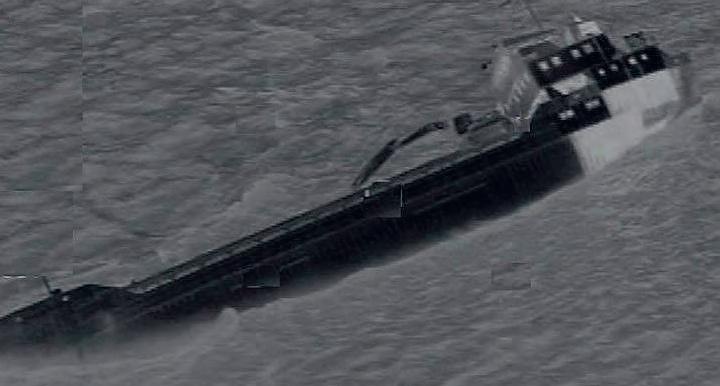
Dynamic separation of soil cargo contributes to sinking
As edited from the Norwegian Accident investigation report Sjøfart 2023/01 (original report only available in Norwegian)
A small bulk carrier was carrying a load of soil that had been loaded, in bulk, into the single hold. The soil had been stored in unprotected heaps ashore and was loaded using an excavator. During loading, it was observed that some of the soil “flowed” across the cargo hold when released by the excavator.
Once loading was finished, the cargo was evenly distributed in the cargo hold, although slightly higher in the middle of the heap. The crew readied the vessel for the voyage and closed the cargo hatches. Once underway, they encountered increasing swells and wind from starboard. Somewhat later, the vessel started listing to port, and the crew suspected that the cargo had shifted. This was confirmed visually when crew saw that moist soil was sloshing on top in the middle of the hold. This was evidence that either liquefaction or dynamic separation had occurred. The master decided to turn the vessel around and seek shelter. As this manoeuvre was being undertaken, the vessel suddenly took a strong list to starboard and the crew soon realised that they were in danger due to a loss of stability. A distress call was sent and the crew evacuated the vessel by jumping into the sea wearing immersion suits. All five were eventually picked up by
a rescue helicopter. The vessel gradually lost buoyancy and sank as a result of water ingress into the cargo hold and other areas following the loss of stability caused by cargo liquefaction or dynamic separation.
Investigation findings
The official investigation found it likely that there was moisture in part of the stockpiled soil that was loaded. The ship’s movements caused the cargo to undergo a transformation and initiated the sequence of listing events, which culminated in the foundering of the vessel. As it happened, no samples were taken of the cargo, and the cargo was not tested for its transportable moisture limit (TML). The IMSBC Code does not list soil as a Category A cargo, so testing was not a requirement. Neither the shipper nor the vessel’s crew were familiar with the properties of the cargo.
As the report mentions, only special vessel design may help to reduce the potential consequences of cargo shifting when transporting a bulk cargo with an unknown TML. As it stands, there is probably inadequate knowledge in the industry of the requirements that apply to documenting the properties of soil to be carried as bulk cargoes.
Lessons learned
• While liquefaction or dynamic separation has been observed as a key safety issue when dealing with such cargoes as iron ore fines or nickel ore, soil has escaped this attention, probably due to
the relatively low volumes transported by sea in bulk.
• This accident demonstrates that certain soils can liquefy or are subject to dynamic separation under certain conditions of moisture content and vessel movement.
• If, during loading, there is reason to suspect that the moisture content is in excess of the TML, stop loading the cargo, inform the owners and seek further advice from your P&I Club.
• If laboratory tests have not been conducted on the cargo, crew can carry out a complementary test on board, known as the “Can Test” in order to determine, approximately, whether the cargo is at risk of flowing. For example, see the following publication: www. londonpandi.com/media/2142/reducing-the-risk-of-liquefaction-operational-guidance-for-vessels-that-carry-cargoes-which-may-liquefy.pdf
Shortcut is a safety slip: Mars 202420
As edited from TSB (Canada) report M20C0188
The vessel was at anchor. In the early morning hours, a crew member went on deck to check the anchor’s condition. Instead of taking the known recommended route on the starboard side, known as “the safe way to the bow”, he chose the shorter port side option. This route went via a ramp that led up and over some deck piping. While crossing the deck ramp, he slipped

42 SWZ MARITIME • MAY 2024 MARS
Vessel just before foudering.
Instead of taking “the safe way to the bow”, the crew member chose the shorter port side option and slipped.
on the damp surface, lost his balance and fell to the deck from a height of around one metre. The victim complained of a sore left elbow, which had taken the brunt of the fall, and was given first aid. Later that day, he was sent ashore for medical attention.
Investigation findings
The company investigation found that he was not holding the handrail of the ramp while crossing. Also, his choice of routes, using the shorter port side option instead of the starboard “safe way to the bow”, increased the chances of an accident or incident.
Lessons learned
• Shortcuts are rarely the safest option, but they are often taken, especially for mundane tasks, as we feel we are in control and that nothing could happen. But it does.
• Stairs and ramps require three points of contact for a safe passage.
Hatchcover crush fatality: Mars 202422
As edited from Marine Department (Hong Kong) report published October 2022
A bulk carrier in ballast was underway for the next port of loading. The deck crew were coating the vessel’s holds with lime in preparation for cargo. Some crew were in the hold applying the lime while others, in support, were on deck. An officer was on deck in an overall supervisory role.
In the late afternoon, the hold coating operation work was nearing completion. The officer in charge needed to take photos of the coated holds, as required by the charterer. He slipped in between the partially open hatch cover and the hatch coaming to take the pictures. The crew members in the cargo hold heard the sound of the hatch cover moving and a loud yell. The crew members working in the cargo hold came out to the main deck and asked why the hatch cover was closed. The deck crew replied that no one was operating the hatch cover at the time; they had not closed it. The officer was then found caught between the now closed hatch cover and the coaming. A return hydraulic oil hose for the hatch cover operation had
MARS
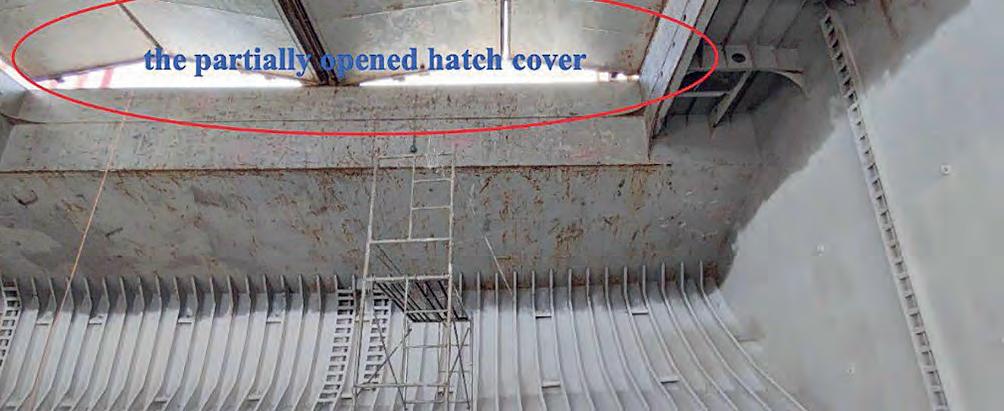
ruptured and the hydraulic oil spilled on deck. This had caused the closure of the hatch by gravity.
The victim was killed instantly. His body was recovered from the scene as soon as the hatch cover control was repaired. Two days later, upon arrival at port, the victim’s body was delivered to shore authorities.
Investigation findings
The investigation found, among others, that the hatch cover hydraulic lines and fittings were not incorporated into the vessel’s planned maintenance system (PMS) so that the manufacturer’s recommendations for use, maintenance and inspection could be correctly employed.
Lessons learned
• The victim probably did not realise he was putting himself in a dangerous position – only the hydraulic pressure was keeping the hatch cover open. When this pressure was released due to a line failure, the hatch cover quickly closed by gravity.
• Keeping hatches slightly open using only hydraulic pressure is a dangerous practice. Any deficiency in the hydraulic line can cause the hatch to quickly close without warning.
• Shipboard safety management system (SMS) procedures and the PMS should incorporate manufacturer’s recommended operation, maintenance and inspection intervals.
Engine room gantry hook defective: Mars 202423
As edited from Marine Department (Hong Kong) report published October 2022
A vessel was in dry dock and crew were engaged in various maintenance tasks. In the engine room, the gantry crane was being used to lift the main engine. The supervisor noticed that the crane’s hook was not able to rotate under load. Work was stopped, the load relieved, and the hook was disassembled to permit investigation. It was found that the inner mechanism of the hook was in poor condition. The thrust bearing was damaged and the threads of the hook were in poor condition.
Lessons learned
• A stop work initiative is always advisable if a dangerous situation arises or if something seems out of the ordinary or not “normal”.

43 SWZ MARITIME • MAY 2024 All Mars
published
Reports are also
online, www.swzmaritime.nl.
During an investigation, it was found that the inner mechanism of the hook was in poor condition.
A return hydraulic oil hose for the hatch cover operation had ruptured, which had caused the closure of the hatch by gravity.
ALGEMENE LEDENVERGADERING KNVTS
Op donderdag 30 mei houdt de KNVTS haar jaarlijkse Algemene Ledenvergadering (ALV). Alle leden zijn welkom om mee te denken over de koers van onze vereniging.
Het Hoofdbestuur zal de resultaten van het afgelopen jaar en de plannen voor de komende periode presenteren.
Dit jaar heeft Koninklijk College Zeemanshoop zijn locatie in hartje Amsterdam beschikbaar gesteld. Dit als voorbode voor een mooie samenwerking. Hapjes en drankjes worden door de KNVTS kosteloos
beschikbaar gesteld. De locatie aan het Spui bij de Munttoren is goed bereikbaar met het openbaar vervoer, maar er kan ook dichtbij geparkeerd worden, of aan de rand van Amsterdam, om vervolgens het OV te nemen. Hierover volgen nog instructies. Aansluitend wordt een etentje georganiseerd. Dit zal voor eigen kosten zijn. Op weg naar de dinerlocatie is er een korte stadswandeling waarin een paar mooie verhalen over de historie van Amsterdam worden gedeeld.
Aanvang: 14.30 uur, inloop vanaf 13.30 uur
Einde: circa 16.30 uur
Locatie: Koninklijk College Zeemanshoop, Muntplein 10a, Amsterdam
De ALV is uitsluitend voor KNVTS-leden. Aanmelden kan via de KNVTS-website. Rond 16.30 uur wordt de ALV afgerond. Daarna is de bar geopend voor een borrel en netwerken, voordat we vertrekken voor een historische wandeling en diner in hartje Amsterdam.
INTERNATIONAL CONFERENCE ON POSTGRADUATE
RESEARCH IN MARITIME TECHNOLOGY
The 2024 International Conference on Postgraduate Research in Maritime Technology (PostGradMarTec 2024) will again provide a unique opportunity for younger postgraduates to present and discuss their work, both complete and in progress, and to meet other young maritime professionals from universities and industry worldwide in an international conference environment.
PostGradMarTec 2024 will be held online on 27-28 November 2024, and is organised on behalf of the Confederation of European Maritime Technology Societies (CEMT) by the Royal Institution of Naval Architects (RINA). Registration will be free for postgraduate and undergraduate students. Details of the Conference are published at www.cemt.eu/PostGradMarTec-2024.
VACATURE: ALGEMEEN SECRETARIS KNVTS
Als algemeen secretaris ben je het dagelijkse “gezicht” van de vereniging. Het is een zeer zelfstandige en brede rol die naast financieel-administratieve verantwoordelijkheid ook veel organisatietalent en communicatief vermogen vraagt. Als steunpilaar van het hoofdbestuur, bestaand uit vrijwilligers uit het technisch-maritieme cluster, zal je tal van projecten coördineren, zorgen voor een goede afstemming en
organisatie van de verenigingsactiviteiten en de social-media-uitingen bewaken.
• Taken: administreren, coördineren en organiseren van verenigingsactiviteiten.
• Projecten: prijsuitreikingen, lezingen, social media, financieel-administratief.
• Belangrijkste vereisten: organisatietalent, nauwkeurigheid en enthousiasme.
Postgraduates wishing to present their research at PostGradMarTech 2024 are now invited to submit an abstract (250-500 words). Authors of selected abstracts will be invited to submit a paper/extended abstract (20003000 words). Presented papers will be freely available online post-conference, and with open copyright, allowing papers to be subsequently offered for reviewed publication.
• Locatie: Rotterdam.
• Arbeidsvoorwaarden: flexibel in te delen, 24 tot 32 uur per week. Dertig vakantiedagen per jaar bij fulltime inzet. Goed salaris, pensioen, reiskosten, etc. Vanzelfsprekend krijg je jouw “gereedschapskist” (laptop, etc.).
Wil je meer weten? Neem dan contact op met Eric Schiphorst: +31(0)6-13351354 of solliciteer direct: eric@vanstorm.nl
SWZ|Maritime is onder meer het periodiek van de Koninklijke Nederlandse Vereniging van Technici op Scheepvaartgebied, opgericht in 1898. SWZ|Maritime verschijnt elfmaal per jaar. Het lidmaatschap van de KNVTS bedraagt € 110,00 per jaar, voor juniorleden € 55,00 per jaar, beide inclusief dit periodiek. Een digitaal lidmaatschap (alleen voor studenten) kost € 20,00 per jaar. Het geeft u de vooraankondigingen van de maandelijkse lezingen, te houden op vier verschillende plaatsen in Nederland en korting op verschillende activiteiten. U kunt zich opgeven als lid bij de algemeen secret aris van de KNVTS, Zeemansstraat 13, 3016 CN Rotterdam, e-mail: secretariaat@knvts.nl of via het aanmeldingsformulier op de website: www.knvts.nl.
44 KNVTS
SWZ MARITIME • MAY 2024
LEZINGENPROGRAMMA KNVTS
11 juni
Lezing: Automate the boring, engineer the awesome
Hoe kan de efficiëntie van elektrische energiesystemen worden verbeterd? En hoe kan dit resulteren in aanzienlijke besparingen op het gebied van tijd en geld, maar ook de vermindering van potentiële risico’s?
Matthijs Mosselaar van Alewijnse geeft met deze lezing een toelichting over de engineering-tools die ontwikkeld zijn voor modellering en simulaties waarmee het engineeringproces effectief geautomatiseerd wordt en de efficiëntie van elektrische energiesystemen wordt verbeterd.
Voertaal: Nederlands
Zaal open: 19.30 uur
Start: 20.00 uur
Einde: 21.45 uur
Locatie: NHL Stenden Hogeschool, Rengerslaan 10, Leeuwarden
Toegankelijk voor: leden en introducé(e)s
Bijdrage: gratis
Aanmelden via de KNVTS-website.
Bijzonderheden: Om uiterlijk 22.00 uur dienen wij het gebouw te verlaten, de nazit is bij Wannee.
Aanvang diner vooraf: 18.00 uur
Locatie: Restaurant Wannee, Rengerslaan 8, Leeuwarden
Bijdrage: diner op eigen kosten
11 juni
Lezing: CMB.Tech; de rol van dual-fuelverbrandingstechnologie in het transitieverhaal van de scheepvaart
We weten allemaal dat we moeten vergroenen in elke sector. Maar hoe begin je hieraan in een conservatieve sector zoals die van de scheepvaart, waarbij schepen gemakkelijk 25 jaar commerciële levensduur hebben en ze vaak 6000 uren per jaar rondvaren met grote vermogensbehoefte. CMB.Tech is een pionier en referentie op het vlak van sustainable shipping . In 2017 hebben ze de eerste passagiersferry met dual-fuel-waterstoftechnologie gebouwd. Sindsdien hebben ze een nieuwbouwprogramma opgezet dat meer dan vijftig zeeschepen omvat die met waterstof of ammoniak zullen worden aangedreven. Roy Campe, de CTO van CMB.Tech, vertelt
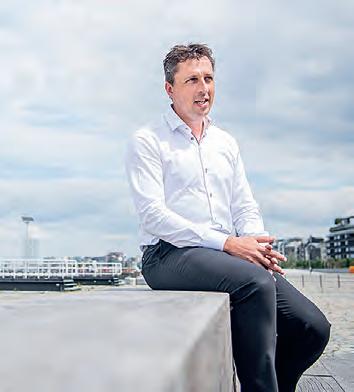
hoe hun eerste projecten tot stand zijn gekomen en hoe het verhaal nu verder wordt uitgebouwd. Tijdens de presentatie worden ook de Hydrotug en Hydrocat toegelicht. De technologie en de rol van de dual-fuel-verbrandingstechnologie wordt uitvoerig toegelicht als sluitsteen om een kosten-effectieve energietransitie mogelijk te maken.
Voertaal: Nederlands
Zaal open: 19.30 uur
Start: 19.45 uur
Einde: 22.00 uur
Locatie: Delta Hotel, Maasboulevard 15, Vlaardingen
Toegankelijk voor: leden en introducé(e)s
Bijdrage: 5 euro voor leden / 10 euro voor niet-leden
Aanmelden voor 11 juni via de KNVTS-website.
Bijzonderheden: na de lezing is gelegenheid tot het stellen van vragen en na te praten onder het genot van een drankje
27 juni
TekTalk: Unmanned vehicles in naval warfare
Over the course of recent years, a revolution has been underway on the modern naval battlefield. On the 1st of February of this year, a video surfaced on the internet of the sinking of the Russian Navy’s Tarantul Class corvette Ivanovets by the Ukrainian armed forces. Since then, the use of these unmanned assets by the Ukrainian military
has shown unprecedented success. The operational impact of unmanned surface drones on the modern naval battlefield cannot be understated.
In this TekTalk, jointly organised by KNVTS and KIVI Martec, Rui Costa will take us by the hand through the history of unmanned systems in naval warfare, the current developments and challenges in technology, and the outlook of innovations, countermeasures, and the opportunities for non-governmental applications.
Costa is a gifted speaker and publisher on this topic. Currently working at Damen Naval in Vlissingen, he joined the organisation in 2023 after a career in the Portuguese Navy. He will be our guide and source of information, but we aim to have an open discussion to share and gain insights.
Hall open: 18:00
Start: at 18:30 you are welcome to join us for some sandwiches, at 19:30 the presentation starts
End: around 21:00 the TekTalk will end, afterwards the bar is open until 22:00 for drinks and networking
Location: KIVI building, Prinsessegracht 23, Den Haag
Accessible for: KIVI and KNVTS members and anyone interested in this topic
Contribution: For KIVI and KNVTS members we ask for a contribution of 10 euros for sandwiches and drinks. The contribution for non-members is 20 euros.
Sign up at knvts.nl/events
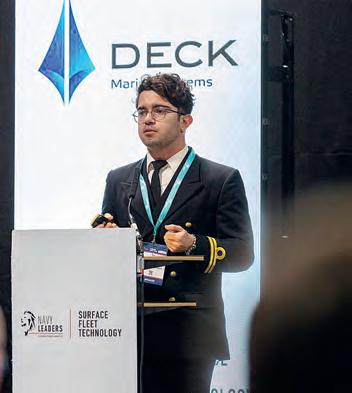
45 KNVTS
Rui Costa bespreekt de geschiedenis van onbemande systemen in naval warfare.
SWZ MARITIME • MAY 2024
Roy Campe, de CTO van CMB.Tech licht tijdens de presentatie ook de Hydrotug en de Hydrocat toe.

ADVANCING SUSTAINABILITY IN DREDGING
Dutch investment in nature-based solutions
Amidst global challenges of climate change, biodiversity loss, and sustainable development, naturebased solutions (NbS) are gaining prominence as effective responses that can improve the sustainability of dredging projects. With projections indicating a rise in global funds for climate investment, € 700 to 800 billion by 2050 [1], there is a clear global drive across all industries to invest in innovative approaches to better protect the environment. In the Netherlands, a ten-year Dutch initiative backed by the Dutch government has kicked off.
TEXT: JESSICA GONZALEZ, ARTICLE SUPPLIED BY CEDA, CEDA@DREDGING.ORG
Across the global dredging industry, there's a growing exploration of NbS techniques to mitigate environmental impacts and bolster ecosystem resilience. Examples include sediment management and beneficial reuse, showcased in projects like the Randle Reef Sediment Remediation Project in Hamilton Harbour, Canada [2], which repurposes dredged material to create confined disposal facilities, reducing contaminant spread and supporting aquatic habitat. Similarly, ecosystem-based dredging methods, such as those demonstrated in the Maasvlakte 2 expansion project in the port of Rotterdam, the Netherlands [3], integrate habitat creation and selective dredging to minimise ecosystem disturbance and promote ecological restoration. While there is growing recognition of the value of NbS, wider uptake in dredging remains slow. Speaking to CEDA Industry News, Simon Haafs, coordinator of knowledge and innovation at the Dutch Ministry of Infrastructure and Water Management notes that this is in large part due to more traditional cost-based assessment models,
procurement methods and legislations that are not adapted for NbS. In a bid to push forward the development and wider-uptake of NbS in Europe’s dredging industry, the NL2120 consortium has been created, driven by a major € 110 million investment from the Dutch government, first announced in February 2023. It will lead a decadelong effort to propel NbS adoption within Europe's dredging industry. This major injection of funding underscores the growing recognition of NbS as a crucial component of dredging, driven by a rising demand for sustainable practices.
Collaboration with key stakeholders in the dredging industry, including Van Oord and Boskalis, associated with NL2120, will help provide valuable insights into the complexities and obstacles of NbS adoption and strategies to address them.
Dredging sector benefits
The participation of dredging companies in the NL2120 initiative offers a unique opportunity to champion sustainability within their op-
46 SWZ MARITIME • MAY 2024 CEDA NEWS
Photo: The Sand Engine in the Netherlands is a nature-based solution for coastal defences (by Rijkswaterstaat).
ABOUT CEDA
The Central Dredging Association (CEDA) is an internationally recognised independent professional association. It is an easy-to-access leading platform for the exchange of knowledge and an authoritative reference point for impartial technical information. CEDA actively strives to contribute towards sustainable development by strongly recommending working with nature. CEDA members are corporations, professionals and stakeholders, involved in a diversity of activities related to dredging, marine construction and dredged sediment management. CEDA represents the common interest of all fields related to dredging and does not promote the interest of any particular industry sector or organisation.
www.dredging.org
erations. By leveraging the resources provided by NL2120, companies can also access the latest research and development focused on NbS, enhancing their capabilities.
Furthermore, the consortium's emphasis on strengthening critical enablers for sustainable dredging, such as management programmes and institutional frameworks, is poised to help companies integrate sustainable practices into daily operations.
As Petra Dankers, a key figure in NbS initiatives at Royal HaskoningDHV, tells CEDA Industry News: ‘Some enablers are more obvious for RHDHV work and some are more related to other businesses. For example, electrification of dredging is more something for the dredging industry itself, however, knowledge on beneficial use of sediments, how to create landscapes without sandy terrain and especially how to organise the business case, take care of the legislation and provide well thought of maintenance programmes are things that are of strong interest.’
Additionally, NL2120 facilitates networking opportunities, allowing companies to collaborate with governmental bodies, NGOs, and industry partners to promote sustainability in dredging. Overall, participation in NL2120 empowers dredging companies to lead the industry in sustainable practices, driving positive change and environmental stewardship.
Hurdles to adoption
NbS often provide greater value, as Alex Hekman, chairman of NL2120, highlights to CEDA Industry News. ‘NbS address societal challenges while benefitting both people and nature, aligning with natural dynamics and offering adaptability against climate change impacts.’ For instance, NbS coastal defences like sand engines, barrier islands, or eco-friendly substrates, as demonstrated by projects like The Sand Motor and Hondsbossche Pettemer Duinen [4], contribute significantly to flood safety in the Netherlands. However advantageous NbS may appear, their integration into the dredging sector has been sluggish. According to research [5] from the WWF, barriers for NbS include a range of implementation, financial, policy, political, environmental and social risks to persuade pri-
vate investors of its benefits, who may be put off by seemingly higher costs. Crafting a persuasive business case for NbS requires assessing factors such as long-term costs, estimated benefits (including social, environmental and economical), and risk assessment. WWF outlines common success factors for the bankability of NbS projects, including insurance or credit guarantees that could cover part or all of the loss of a third party financing transaction in the case of non-repayment or loss of value.
The greater added value of NbS will need a shift in business models
For many, these obstacles make sticking with well-established technical solutions more desirable. Hekman underscores this barrier, stating: ‘We perceive it as our mission to demonstrate that NbS offer significant advantages, compelling projects to adopt them and the opportunity to invest in solutions that deliver greater added value. To tackle these obstacles, we assembled specialised teams dedicated to researching these barriers, and their solutions.
Through pilot projects, we aim to showcase the effectiveness of our proposed solutions.’
This greater added value will need a shift in business models, not just looking at the upfront costs, but total life-cycle costs. For NbS projects, upfront costs may be higher than with traditional infrastructure, however, maintenance costs over the life cycle are likely to be lower. Furthermore, longer term economic benefits of projects might materialise over time, and environmental benefits (for example, water purification) as well as social benefits (improved quality of life in the local area), though difficult to compute, must be taken into consideration when looking at total life-cycle costs.
Partnering for progress
With a budget exceeding € 150 million, NL2120 operates within eleven work packages and stands as one of the largest global partnerships in the NbS field. One of the consortium’s driving goals is to foster coordinated efforts across NbS research, development and innovation needed to prove and scale up NbS techniques.
With 25 diverse organisations – from governmental bodies to knowledge institutes, nature organisations, engineering firms, and dredging companies – it is financed through the National Growth Fund. The consortium also collaborates with a broad base of stakeholders to ensure a development of systematic knowledge to create largescale solutions, with a focus on practical examples and practical pilot projects. Information is shared via publications and regular meetings to exchange knowledge and skills.
Stakeholder engagement is recognised as pivotal in the success of any NbS implementation, according to Dankers: ‘Within NL2120, governmental bodies, NGOs, and local communities are already actively participating, enabling the effectiveness of projects.’
It is hoped that the programme's ongoing learnings and practical
47 SWZ MARITIME • MAY 2024
CEDA NEWS
CEDA
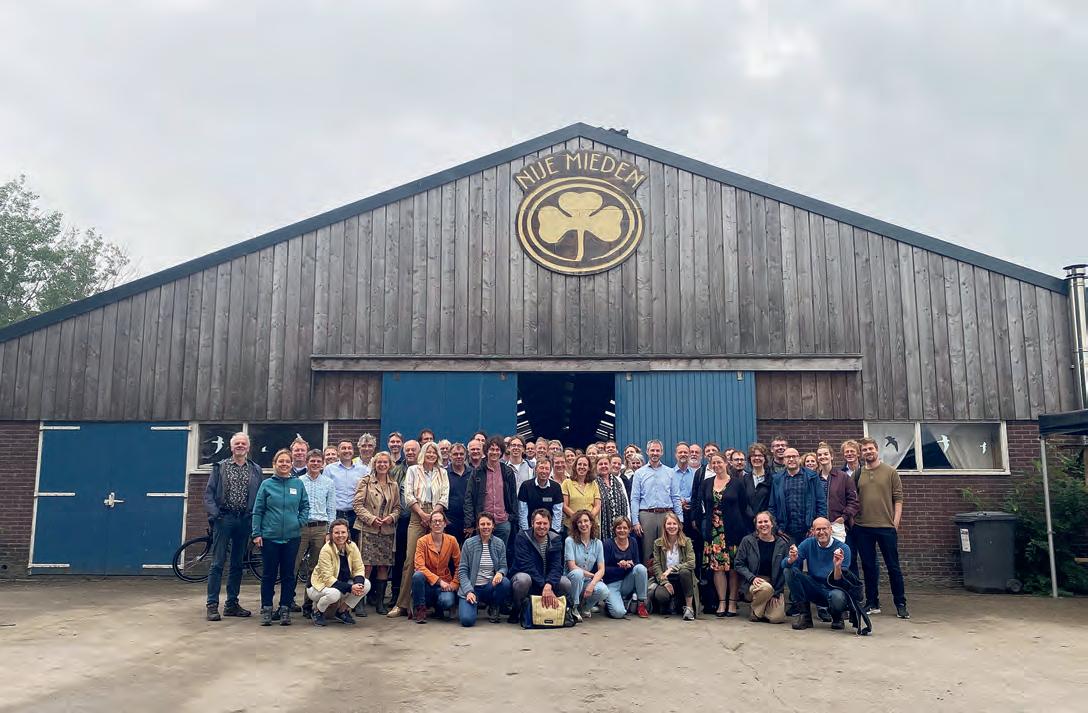
experiences will contribute to more effective Dutch policy, coordinating with ministries for water infrastructure and management, agriculture and food quality and environmental standards.
Governmental investment dynamics
The Dutch government's significant investment in the NL2120 consortium serves to demonstrate its commitment to sustainability, innovation, and climate action. Haafs tells CEDA Industry News: ‘To safeguard our earning capacity and ensure safe living and working conditions, fundamental adjustments in land use, soil, and water management are imperative.’
A core goal within the NL2120 programme initiative is not only to position Dutch businesses to lead in the global NbS market, but also empower landowners to effectively utilise NbS to boost economic growth.
NL2120 is anticipated to yield substantial economic benefits, contributing to cumulative growth in Dutch GDP by € 1075 million in 2050. This growth primarily stems from additional exports of Dutch NbS and increased production in land-based sectors. Furthermore,
REFERENCES
1. https://www.climatepolicyinitiative.org/wp-content/ uploads/2023/09/How-big-is-the-Net-Zero-financinggap-2023.pdf
2. https://www.randlereef.ca/
3. https://www.portofrotterdam.com/en/building-port/ ongoing-projects/new-port-area-sea
4. https://dezandmotor.nl/en/
5. https://www.wwf.org.uk/sites/default/files/2022-08/ Common-success-factors-for-bankable-NbS-report.pdf
NL2120 is expected to generate additional social benefits, including improved health, biodiversity, and a significant reduction of climate damage, amounting to an additional cumulative value of € 880 million in 2050.
Leading the way
The investment marks a significant step forward in advancing NbS within the dredging sector, with the aim of seamlessly integrating these solutions into mainstream practices whenever feasible.
Achieving this goal involves adjusting policies and institutional frameworks to encourage adoption while deepening the understanding of their effectiveness and implementation.
NL2120 presents an opportunity for spatial development projects and partners to leverage their expertise for shaping the future distribution of people and activities within different spaces. Spatial development, primarily guided by the public sector, involves planning the layout of communities and regions, including land use and infrastructure. By integrating NL2120’s expertise, local and regional governments can enhance their development strategies and regulations, fostering sustainable land use and growth.
Additionally, the consortium plans to invite educational institutions to participate in capacity-building programmes focused on NbS, with the aim of scaling up NbS implementation and enhancing knowledge dissemination. This initiative is expected to be opened to additional participants in the second year, starting in 2025.
The Dutch government’s investment in NL2120 signifies a transformative shift toward sustainability through NbS. It is clear it sees the value in investing significantly in this burgeoning area and dredging should take note. By leveraging innovative solutions, the dredging industry can enhance its resilience to climate change impacts while contributing to ecosystem preservation, as well as opening up potential greater opportunities for revenue.
48 SWZ MARITIME • MAY 2024
NEWS
Group photo of NL2120 on 28 June 2023 (photo EcoShape).
Electronics

Bachmann electronic
Bachmann electronic
Vendelier 65-69
3905 PD Veenendaal
Tel: +31 (0)85 2100550
E-mail: r.epskamp@bachmann.info www.bachmann.info
Contact: Ronald Epskamp
At Bachmann, our mission is to bring together a wide range of partners, customers, product managers and application support engineers to share individual strengths, ideas, solutions and technologies. Our goal is to learn from ship owners and translate their vision into tangible automation solutions. We strive to facilitate industry-wide collaboration, which will enable system integrators and equipment manufacturers to focus on their unique, high quality, fully tested solutions with minimum development and commissioning time.
Experts & Surveyors

Doldrums B.V.
Marine & Technical Surveyors
Waalstraat 26 3087 BP Rotterdam
Tel. +31-(0)10-4299590
Fax +31-(0)10-4296686
E-mail: office@doldrumsbv.nl www.doldrumsbv.nl
Custom naval engineering solutions
S ALTWATER
Custom nava l engineering solutions
Saltwater Engineering
Buitendijks 33 3356 LX Papendrecht
The Netherlands
T +31(0)78–205 15 00
E-mail: info@saltwater.nl www.saltwater.nl
Agile. Competent. Transparent. Reliable. Saltwater Engineering is your partner in naval engineering solutions.
We provide tailor-made solutions for the naval and offshore industry. Our highly skilled and experienced team of engineers offers a broad range of services involving vessel design, mobilization & transport engineering, on-site service and engineering support. A proven track record shows that we are competent and can handle any navel engineering request. Together we will find the best solution for your challenge.
Ship
supplies

WINEL
Dr. A.F. Philipsweg 55, 9403AD
PO Box 70, 9400 AB Assen, The Netherlands
T: +31 (0)592 366 060
E-mail: info@winel.nl www.winel.nl
Safety at Sea Level
Since 1956 Winel has specialized in manufacturing a wide range of products for the commercial shipbuilding and yacht building industry, including:
- Ship doors & hatches
- Tank vent check valves
- Access equipment
- Boarding ladder
- Custom-engineered solutions
Based in Assen, with workshops in Blokzijl and Haiphong, we are a unique partner, housing engineering, production, assembly and testing all under one roof. With our skilled staff, we strive to uphold our company’s key principles: quality without compromise, reliability and customized solutions to ensure your safety at sea.
Maritime training
Nova College Scheepvaart
The Maritime Academy of Nova College is based in IJmuiden and Harlingen. Established over a century ago, it is one of the oldest and most experienced maritime training institutes in the Netherlands. All locations are geared to their specialism, preparing people for all modern functions at sea and on shore.
Internationally certified
A wide range of training and education programmes are available, for professionals in the maritime industry both nautical and technical in the merchant navy, fishery and inland navigation. Operators of locks and bridges are also trained and the Academy participates in various consultancy and research assignments. Contract education by the Academy is internationally certified. www.novacollege.nl/scheepvaart +31(0)23 530 2900 scheepvaart@novacollege.nl
Shiprepair and maintenance

Stout Pijpleidingen en Technische Installaties
Rivierdijk 641a
3371EE Hardinxveld-Giessendam
Tel. + 31 184 615022
Email: info@stout-pijpleidingen.com www.stout-pijpleidingen.com
Since 1979, Stout has been manufacturing and installing highly qualified customized piping systems for shipbuilding and industry. In addition to a team of professionals, we have advanced machines for cutting, bending, and welding pipework in our workshop of more than 4,000 m². Stout is your ISO and VCA** certified partner for production and installation of all custom build piping systems for dredging, ballast water treatment, HVAC, oil, fuel, cooling water, freshwater, firefighting, sewage

EDR Antwerp Shipyard Industrieweg 11, quay 403, 2030 Antwerp – Belgium
T: +32 3 253 27 52
E: info@edr-antwerp.eu www.edr-antwerp.eu
Commercial questions: philippe. trouillard@edr-antwerp.eu
EDR Antwerp Shipyard, new commercial name of Engine Deck Repair nv – your full service shipyard at the heart of Europe. Providing flexible one-stop shop solutions for vessel maintenance, repair and conversion. Installation of ballast water treatment systems, scrubbers, propeller retrofit, reefer upgrades and many more. Other departments:
• Technical Supplies: sale and purchase of critical spare parts 27/4, supply of original spares or other high-quality solutions, cane load tests, supply of engine parts, insulation services and supplies, etc.
• Spare Part Distribution: logistic activities to transport, pack and store your spare parts and vessel equipment. We transport with our own specialized fleet of trucks and we have in-house custom declared warehousing up to 16.000 m²
• Inland: dedicated department creating a one stop shop for all requirements Captain/Owners and managers of inland vessels may have, including specialized docking rated
SEARCH
Naval architects

DEKC Maritime
Osloweg 110 9723 BX Groningen
Tel. 050-5753950
E-mail: info@dekc.nl www.dekc-maritime.com
DEKC MARITIME (Design Engineering Knowledge Center) offers concept design, basic design, and detail engineering for new build vessels as well as operational support during the lifetime of a vessel. DEKC assists with modifications and mobilizations, and provides project-specific engineering. Our specialists in naval architecture, structural design, mechanical engineering and detail engineering are able to help with every idea or challenge.
Stern tube seals
Technisch Bureau Uittenbogaart Nikkelstraat 7
NL-2984 AM Ridderkerk
P.O. Box 165
NL-2980 AD Ridderkerk
Tel. +31 88 368 00 00
Fax. +31 88 368 00 01
E-mail: info@tbu.nl
Website: www.tbu.nl
Technisch Bureau Uittenbogaart is since 1927 active in the shipping and shipbuilding industry as exclusive agent in the Netherlands, Belgium and Luxembourg for a wide range of A class brands. - SIMPLEX-COMPACT 2000 Seals - Centrax Bulkhead Seals
Heating systems, sales and maintenance
Heatmaster bv lndustrial & Maritime heating systems Bedrijvenpark “Grotenoord” Grotenoord 1
3341 LT Hendrik-ido-Ambacht
The Netherlands Postbus 252
3340 AG Hendrik-Ido-Ambacht
Tel. + 31 78 - 68 23 404
Fax + 31 78 - 68 23 403
Email: info@heatmaster.nl www.heatmaster.nl
Heatmaster, your hottest innovator
Vessel Registration

Hubel Marine B.V.
Karel Doormanweg 5 3115 JD SCHIEDAM
Tel. +31-10 458 7338
A.O.H. +31-65 372 4457
E-mail: registration@hubelmarine.com www.hubelmarine.com
We are the official Flag representative for Panama, Belize. St.Kitts & Nevis, Sierra Leone and Guinea Bissau Ship Registry. Our office is fully empowered to process the registration of your vessel on 24/7 basis and issue the related Flag certificates in our office. Furthermore we issue the Crew Endorsements for your seafarers and perform Flag related Safety & Class Surveys.
Would you like to change flag ? Contact Hubel Marine .. leaders for Vessel registration !
Gearboxes and couplings

BOONE Engineering • Technical Solutions • Trading
L.J. Costerstraat 9, 3261 LH OudBeijerland
P.O. Box 1572, 3260 BB Oud-Beijerland
The Netherlands T + 31 (0)186-618300
E info@boonebv.nl
I www.boonebv.nl
Boone, established in 1974, is a worldwide partner in engineering, technical solutions and trading within the maritime, industry and infrastructure sector. Through the years we developed as a specialist and became partner in production, repair and support in drives for the offshore, dredging and maritime sector.
Boone is distributor for:
• Kumera gearboxes
• Stromag high elastic couplings
• Jaure gear couplings
• Gosan sheaves
• Rhenania gearboxes
• Etron barrel couplings
• Sibre brakes and couplings
• Pneumaflex/Spiroflex couplings
As independent specialist we serviced brands as Keller, Jahnel Kestermann, Flender, Lohmann & Stolterfoht, Stork, Renk, Reintjes, Masson and ZF. We also provide service for thrusters of several brands as: Rolls Royce, Berg, Wärtsilä, Aquamaster and more.
For all your maritime affairs
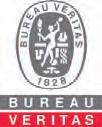
Bureau Veritas Marine Nederland B.V. Gebouw “Willemswerf” Boompjes 40 3011 XB Rotterdam
Postbus 1046
3000 BA Rotterdam
Tel. 010 2822666
E-mail: nld_rtd@nl.bureauveritas.com
Manoeuvring systems, propeller shafts and seals
DNV
Zwolseweg 1 2994 LB Barendrecht Tel. 010-2922817
E-mail: rotterdammarketing@dnv.com www.dnv.com
DNV is the world’s leading classification society and a recognized advisor for the maritime industry. We enhance safety, quality, energy efficiency and environmental performance of the global shipping industry – across all vessel types and offshore structures.
Machinefabriek De Waal
Biesboschhaven Noord 4 4251 NL Werkendam
The Netherlands Tel. +31 (0)183 501811
Email: info@dewaalbv.nl www.dewaalbv.nl
The core business of De Waal mechanical engineering plant and shipping engineering, is: designing and manufacturing Stuwa rudders, steering engines, propeller shaft systems and seals for sea and inland shipping, the fishing industry and the yacht-building industry. The trained technicians have an extensive knowledge of steering machines and propulsion systems. De Waal is a family-owned business, since 1938.
MultiSure B.V.
Contactpersoon: J.L. Niemeijer Tosca 18 2926 PK Krimpen aan den IJssel Tel. 0180 552727 www.multisure.nl
E-mail: info@multisure.nl
MultiSure is specialised in insuring ship’s crew. We help you to be prepared for unexpected situations you do not want to think about.
Would you like to have your company added to our Search pages?
Please contact our account manager Bert Veninga, by phone +31 (0)6 51 586 888 or e-mail bert@veninga.net, for more information.
SEARCH
SEAGOING MANOEUVRING MARITIME TECHNOLOGY
Specialized in insuring ship’s crew?
Sure enough.

An accident is a terrible thing, especially when you are far from home. But you don’t want to dwell on unpleasant scenarios that may never become reality. Multisure understands. We help you to be prepared for unexpected situations you don’t want to think about.
Tosca 18 2926 PK Krimpen aan den IJssel
+31 (0)180 - 55 27 27 info@multisure.nl www.multisure.nl

Dit 11x per jaar verschijnende vakblad SWZ|Maritime wordt uitgegeven door de Stichting Schip en Werf de Zee (SWZ), waarin participeren de Koninklijke Nederlandse Vereniging van Technici op Scheepvaartgebied (KNVTS) en de Stichting de Zee. SWZ|Maritime is het verenigingsblad van de KNVTS. Via participatie in Stichting de Zee van de vakbond van zeevarenden Nautilus International en de Nederlandse Vereniging van Kapiteins ter Koopvaardij (NVKK) hebben ook leden van deze organisaties een abonnement op SWZ|Maritime.
De Stichting SWZ is de eigenaar en uitgever van de titels Schip & Werf de Zee en SWZ|Maritime. Het bestuur van SWZ wordt gevormd door de participanten in SWZ (KNVTS en Stichting de Zee), die elk vier bestuursleden benoemen uit de doelgroepen van de lezers. Het bestuur bestaat uit de volgende personen:
Namens de KNVTS:
Dr. Ir. W. Veldhuyzen (KNVTS), voorzitter
Ing. P. Mast (KNVTS), penningmeester Ing. R. de Graaf (NMT), secretaris
Dr. Ir. M. Th. van Hees (MARIN)
Namens de Stichting de Zee:
W.T. Bos (NVKK)
H. Walthie (Nautilus NL)
De Stichting SWZ wordt bijgestaan door een
Adviesraad waarvan deel uitmaken: mevr. Dr.Ir.
A.C. Habben-Jansen, Prof.Ir. J.J. Hopman, Ir. A.H.
Hubregtse, Ir. P.J. Keuning, Ir. A. Kik, Dr.Ir. H.J. Koelman, mevr. Ir. K. van der Meij, Drs. M. van Rijsinge, mevr. E. Stroo-Moredo, Ir. P.F. van Terwisga, Ing. H.A.B. Veraart, Ir. K. Visser, Ir. A.M. van Wijngaarden, Dr.Ir. P.R. Wellens
Abonnementen
Voor niet leden aangesloten organisaties: Nederland € 179,00*, buitenland € 260,00, dit is inclusief: 11x SWZ|Maritime, de SWZ Newsletter en toegang tot de digitale editie van SWZ|Maritime en het digitale archief. * Deze prijs is excl. 9% BTW en € 3,95 administratiekosten.
Abonnementen worden tot wederopzegging aangegaan. Beëindiging van het abonnement kan schriftelijk, per e-mail of telefonisch geschieden, uiterlijk 3 maanden voor het einde van de abonnementsperiode; nadien vindt automatisch verlenging plaats.
Voor wijzigingen (in adres of opzeggingen) betreffende lidmaatschap van KNVTS: telefoon: 010 - 241 00 94, e-mail: secretariaat@knvts.nl
Voor wijzigingen (in adres of opzeggingen) betreffende het lidmaatschap van leden van Nautilus International: telefoon: 010 - 477 11 88, e-mail: infonl@nautilusint.org.
Voor wijzigingen (in adres of opzeggingen) betreffende het lidmaatschap van leden van de
Al meer dan 75 jaar hét platform voor technische professionals in de maritieme industrie.








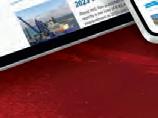

U ontvangt 1x per week de e-nieuwsbrief met het laatste nieuws uit de maritieme sector.
laatste


NVKK en overige abonnementen: telefoon: 0570 - 504 342, e-mail: klantenservice@mybusinessmedia.nl.
Voor klachten over de bezorging kan contact opgenomen worden met Mybusinessmedia: telefoon 0570 - 504 342, e-mail: klantenservice@mybusinessmedia.nl.
Digitale bladversie SWZ|Maritime Abonnees kunnen de digitale online bladerversie lezen op swzmaritime.nl/swz-archive/ met de daarvoor bestemde exclusieve inloggegevens. Voor vragen hierover neemt u contact op met de klantenservice van Mybusinessmedia, 0570 - 504 342, klantenservice@mybusinessmedia.nl.
Uitgeefpartner
SWZ|Maritime wordt uitgegeven in samenwerking met uitgeefpartner Mybusinessmedia, Boreelplein 70, 7411 CG Deventer, telefoon: 0570 - 504 300, e-mail: klantenservice@mybusinessmedia.nl.
Advertentie-exploitatie
Mybusinessmedia, Bert Veninga, accountmanager, telefoon: 06 - 515 86 888, e-mail: bert@veninga.net. Alle advertentiecontracten worden afgesloten conform de Regelen voor het Advertentiewezen gedeponeerd bij de rechtbanken in Nederland.
Adres administratie KNVTS, Stichting SWZ en redactie SWZ|Maritime Zeemansstraat 13, 3016 CN Rotterdam, telefoon KNVTS (abonnementen en lidmaatschap): 010 - 241 00 94, secretariaat@knvts.nl. Redactie (uitsluitend redactionele aangelegenheden): telefoon: 010 - 241 74 35, e-mail: swz.rotterdam@knvts.nl, website: www.swzmaritime.nl.
Redactie: G.J. de Boer, Ir. H. Boonstra, Ir. A. de Bruijn, M. van Dijk, mevr. Ing. A. Gerritsen, Ir. J. Huisman, Ir. J.H. de Jong, Ir. W. de Jong, H.S. Klos, Capt. H. Roorda, B. von Ubisch MSc, E. Verbeek, B. Lenferink (SG William Froude) Aan SWZ|Maritime werken regelmatig mee: B. Kuipers, H. Heynen, E. van Huizen, H.Chr. de Wilde en R. van de Pol
Hoofdredacteur: A.A. Oosting
Eindredactie: mevr. M.R. Buitendijk-Pijl, MA
Vormgeving: Bureau OMA, Doetinchem, www.bureauoma.nl
Druk: Ludlow Media, www.ludlowmedia.nl
Hoewel de informatie, gepubliceerd in deze uitgave, zorgvuldig is uitgezocht en waar mogelijk is gecontroleerd, sluiten uitgever, redactie en auteurs uitdrukkelijk iedere aansprakelijkheid uit voor eventuele onjuistheid en/of onvolledigheid van de verstrekte gegevens. Reprorecht: overname van artikelen is alleen toegestaan na toestemming van de uitgever.
ISSN 1876 - 0236
Colofon
GA
NAAR: SWZMARITIME.NL/NEWSLETTER
Meld u nu aan voor de GRATIS nieuwsbrief!
Smart Shipping & Security for the future

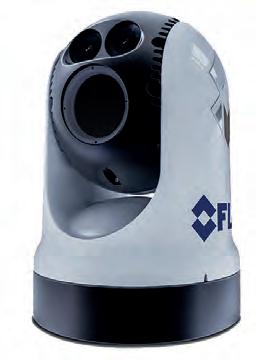
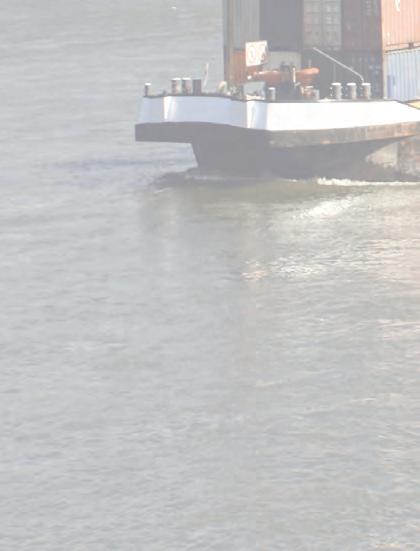

Bridgescout Systems
Most accidents happen when visibility is limited or in hectic or calm situations on board. Ships collide with eachother, hit bridge pilings, exposed rocks and floating objects. This can result in heavy damages to the vessel or even worse, loss of life.

Maritime
On yachts and commercial vessels, SENSOR thermal imaging cameras are being used for night time navigation, shipboard security, man-overboard situations and anti-piracy.


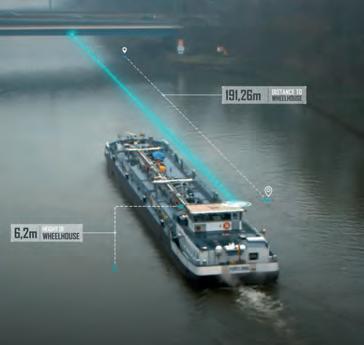

Electrical / Mechanical / Fire detection
In industrial environments, thermal imaging is used to find hotspots that can lead to failures in electrical and mechanical installations. By detecting abnormal temperatures, breakdowns and fire risks can be avoided.
Your contact to us:



Sensor GmbH
Hermann-Hesse-Str. 16a D-41068 Mönchengladbach
+49 (0)2161-4773973
info@sensor-gmbh.de
www.sensor-gmbh.de
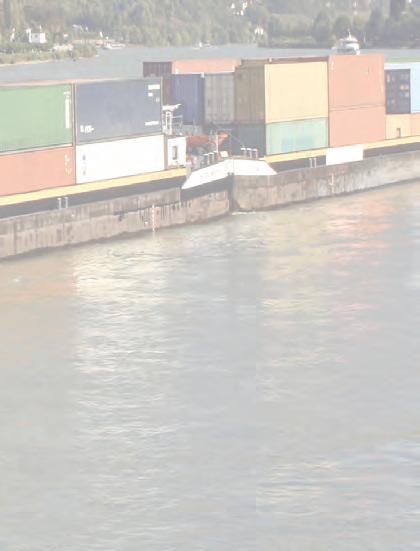
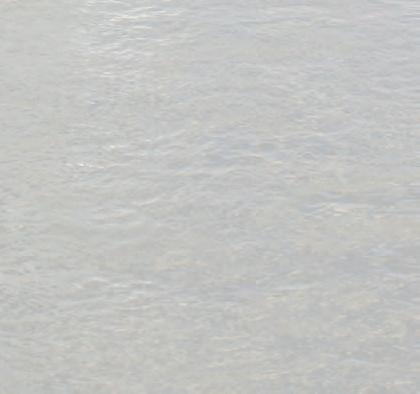

Sensor Maritime Nieuwe Linie 9 NL-5264 PJ Vught
+31 (0)73 - 2200454
info@sensormaritime.com www.sensormaritime.com













 Antoon Oosting Editor-in-Chief swz.rotterdam@knvts.nl
Antoon Oosting Editor-in-Chief swz.rotterdam@knvts.nl











 Dimitri van Heel Senior projectmanager/teamleider Maritime Operations, d.v.heel@marin.nl
Dimitri van Heel Senior projectmanager/teamleider Maritime Operations, d.v.heel@marin.nl








 Hans Heynen
Hans Heynen














































 Elena Prato
Elena Prato















































